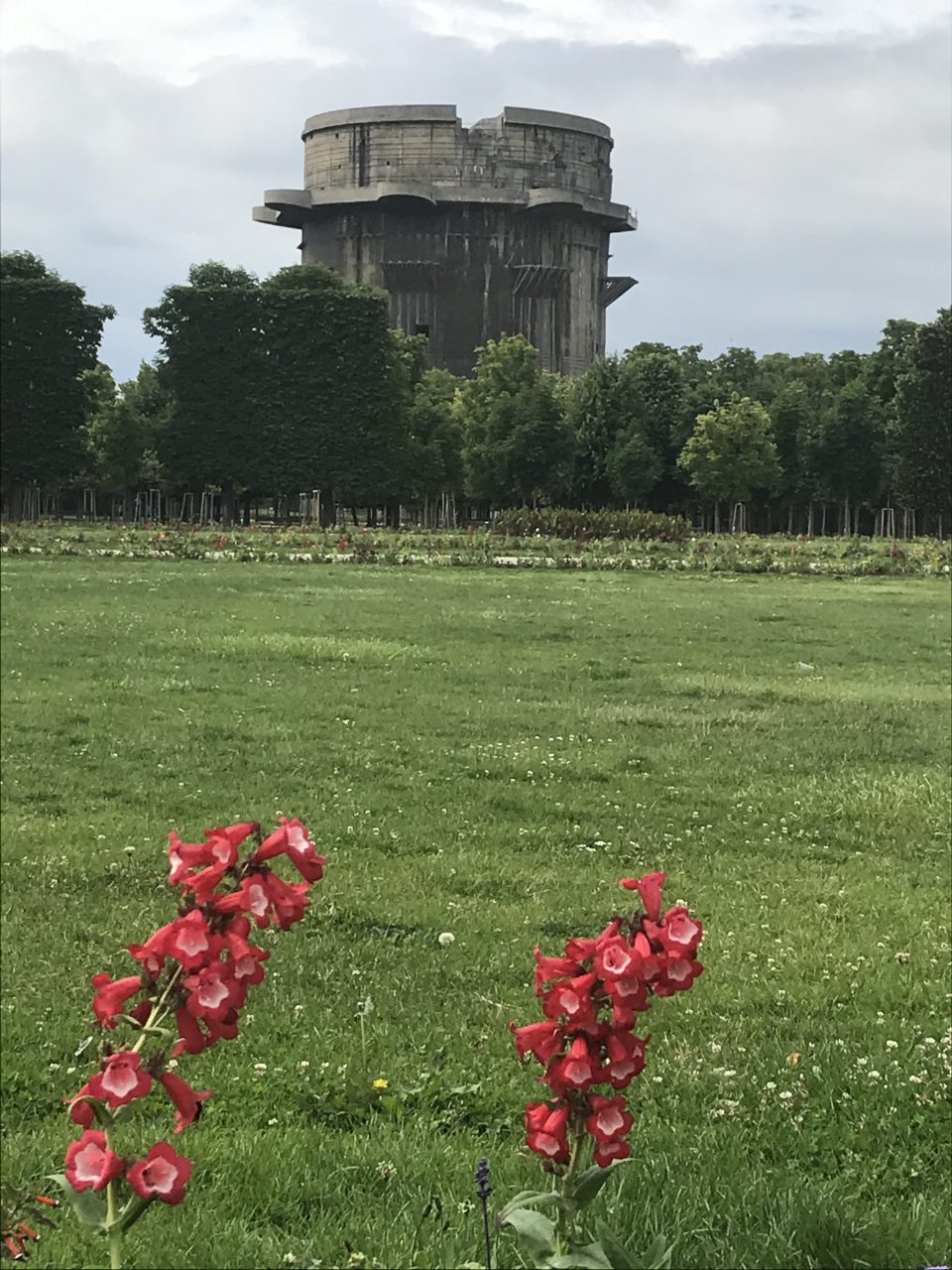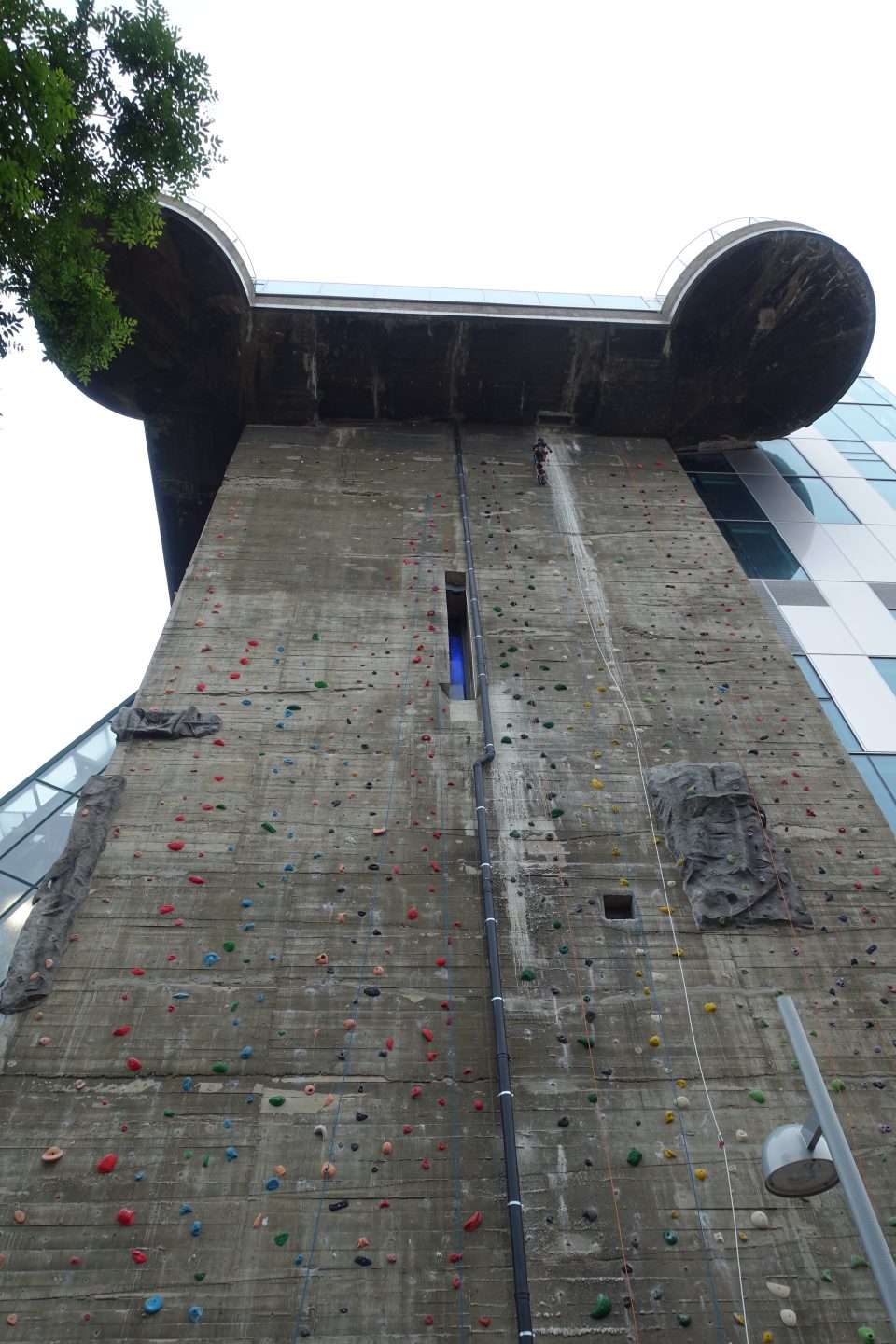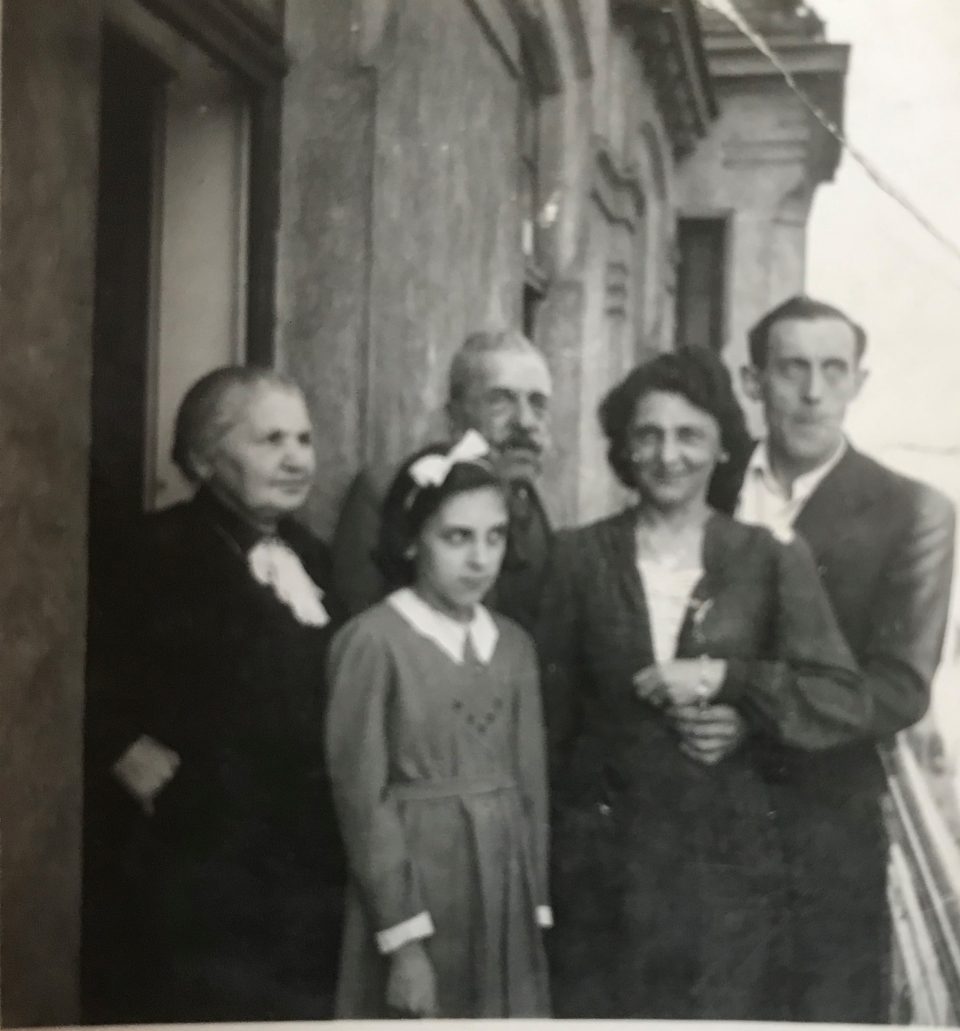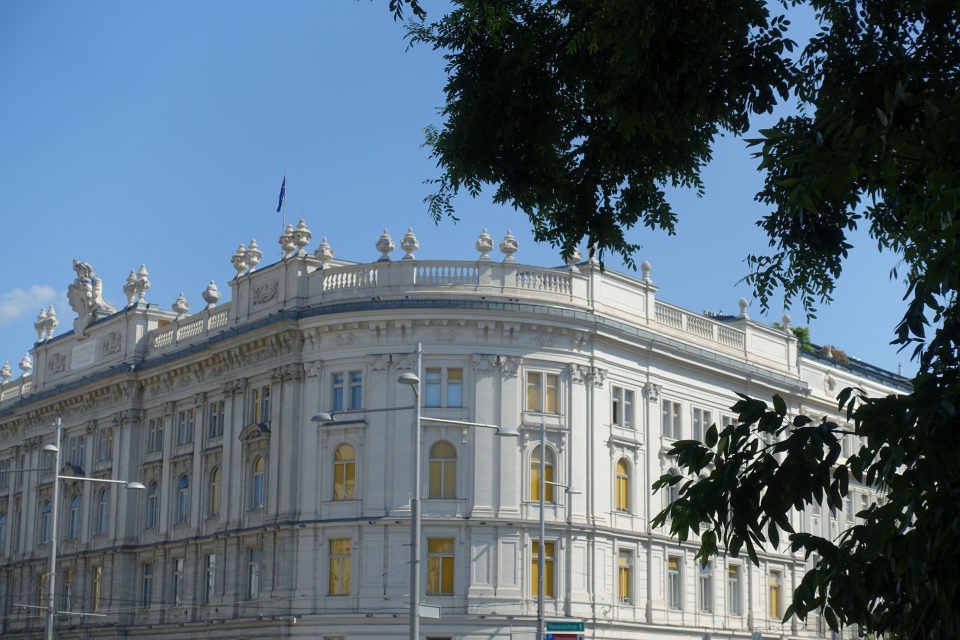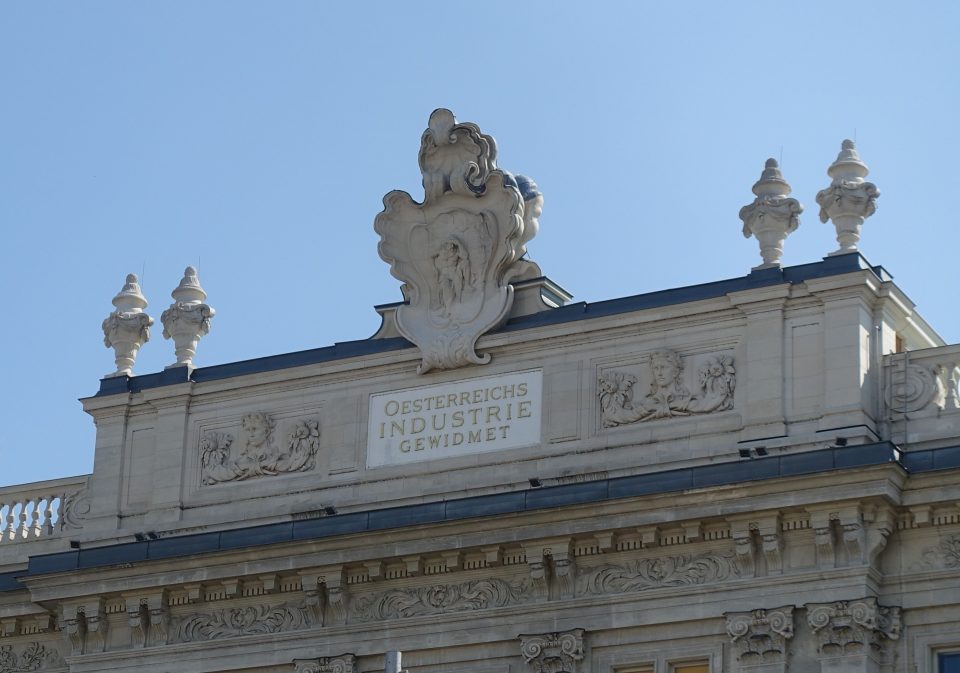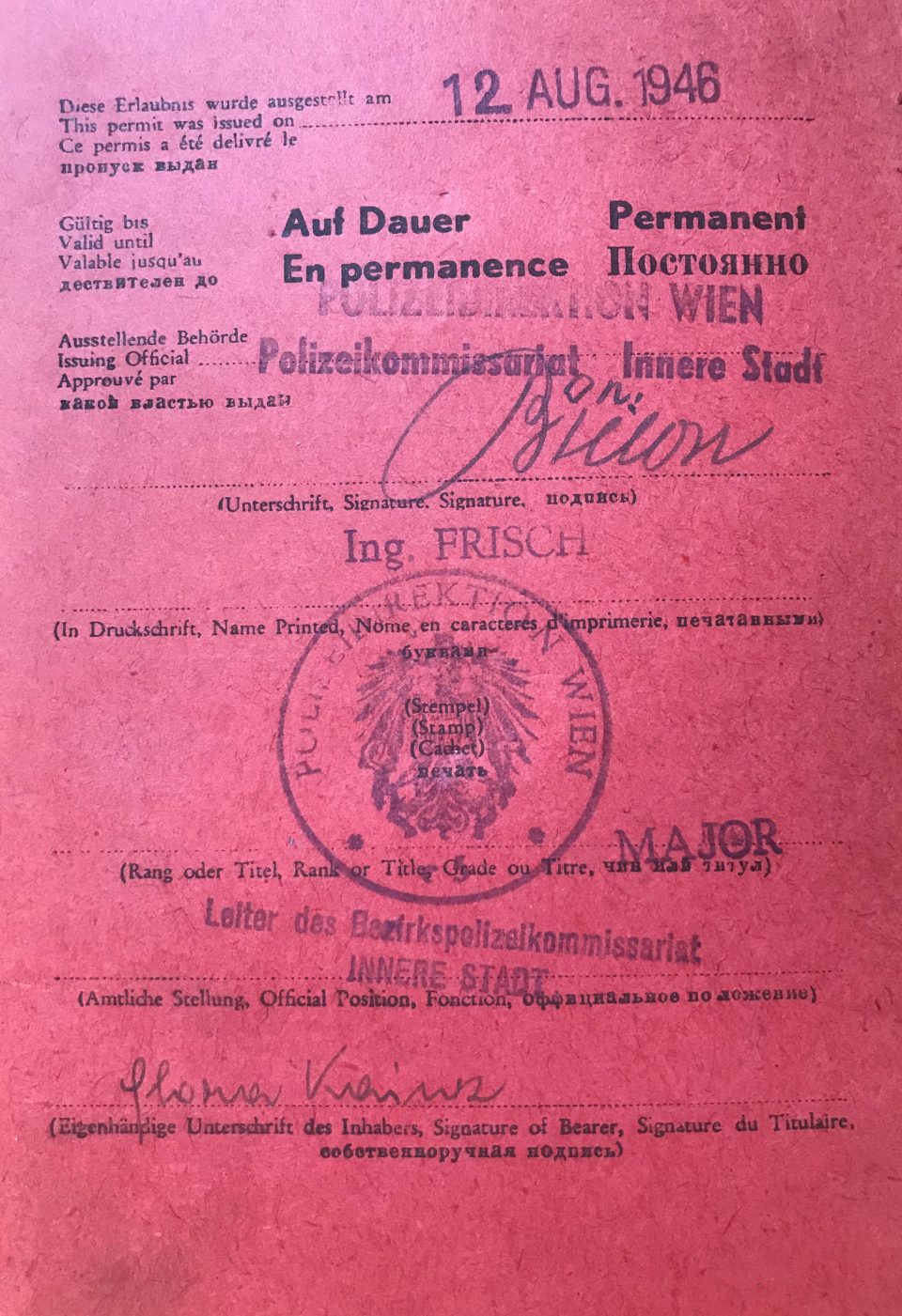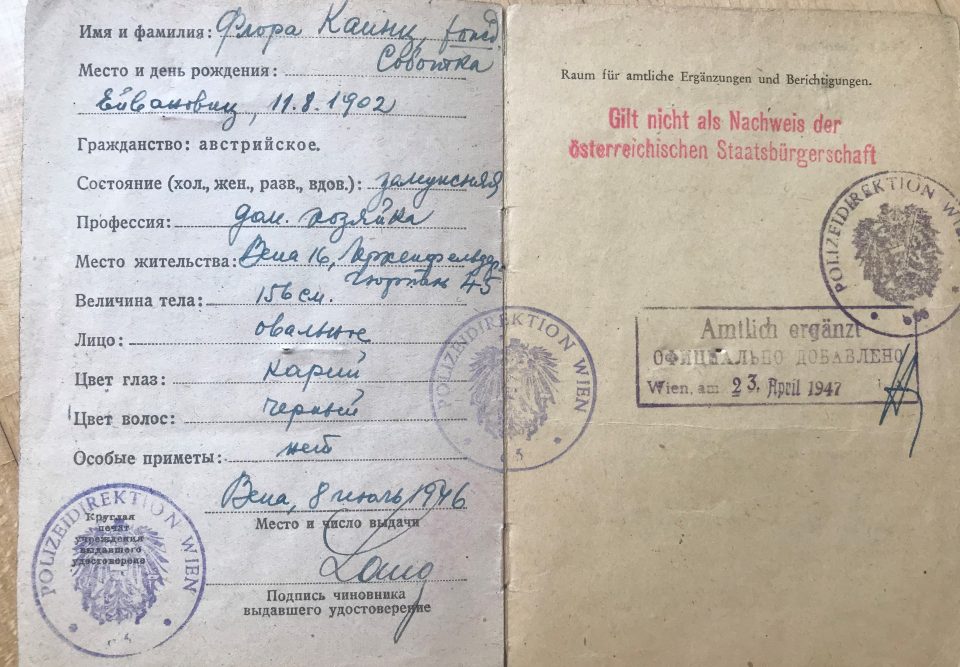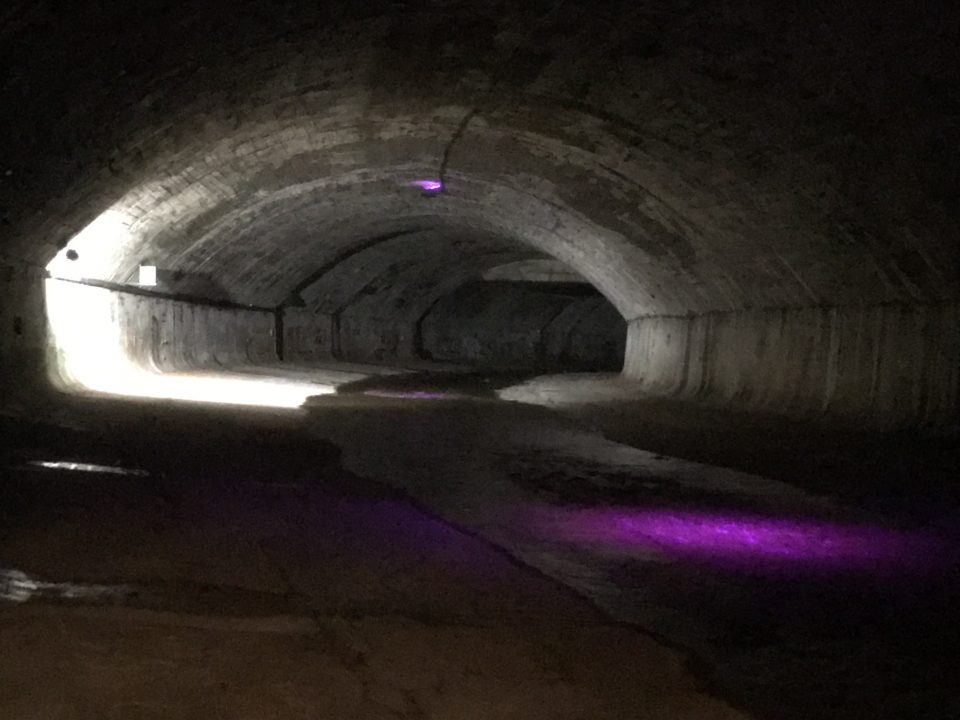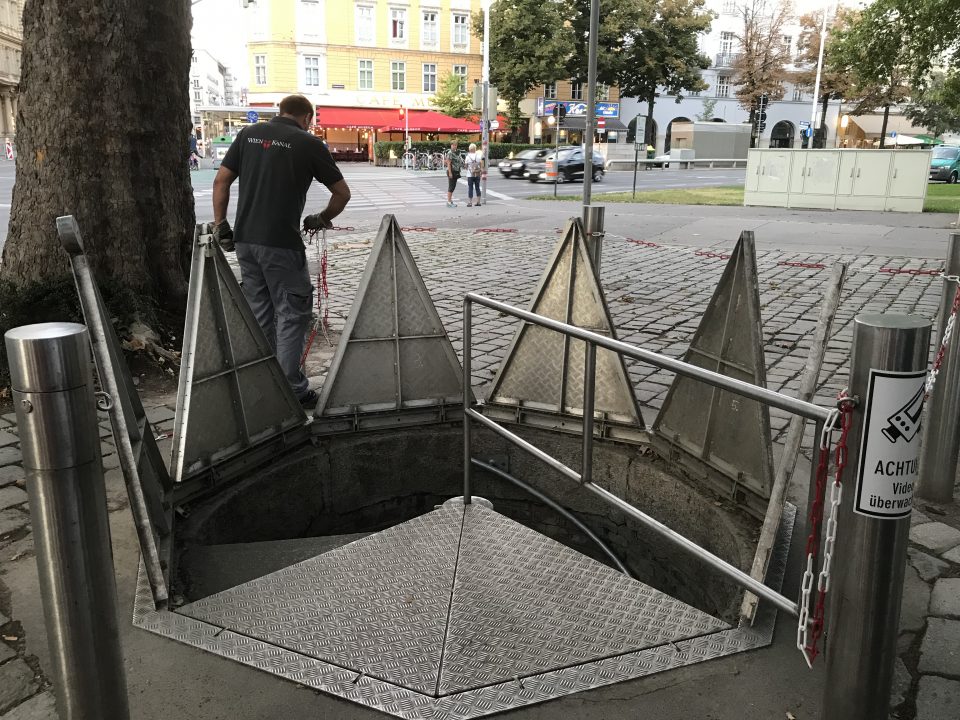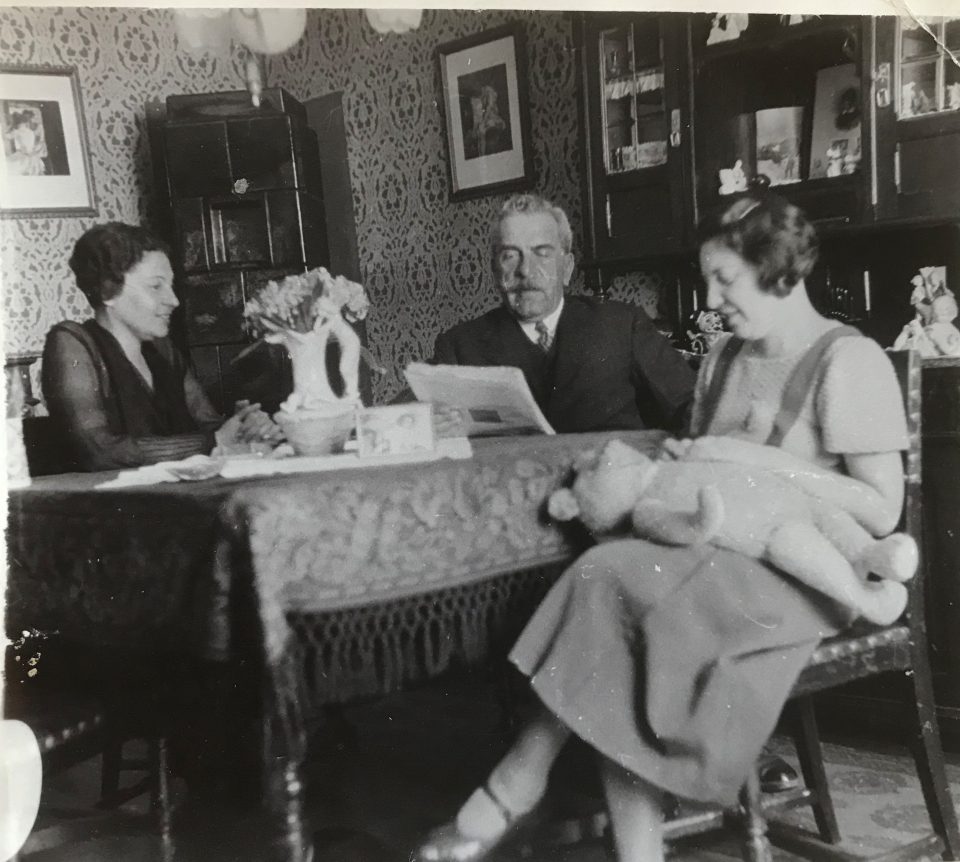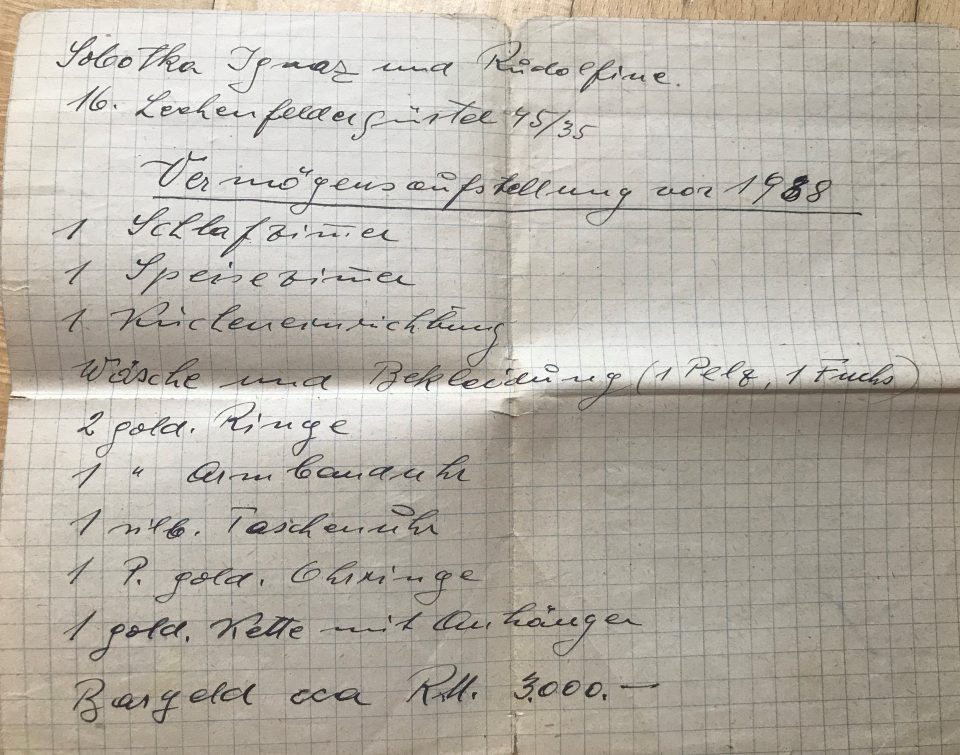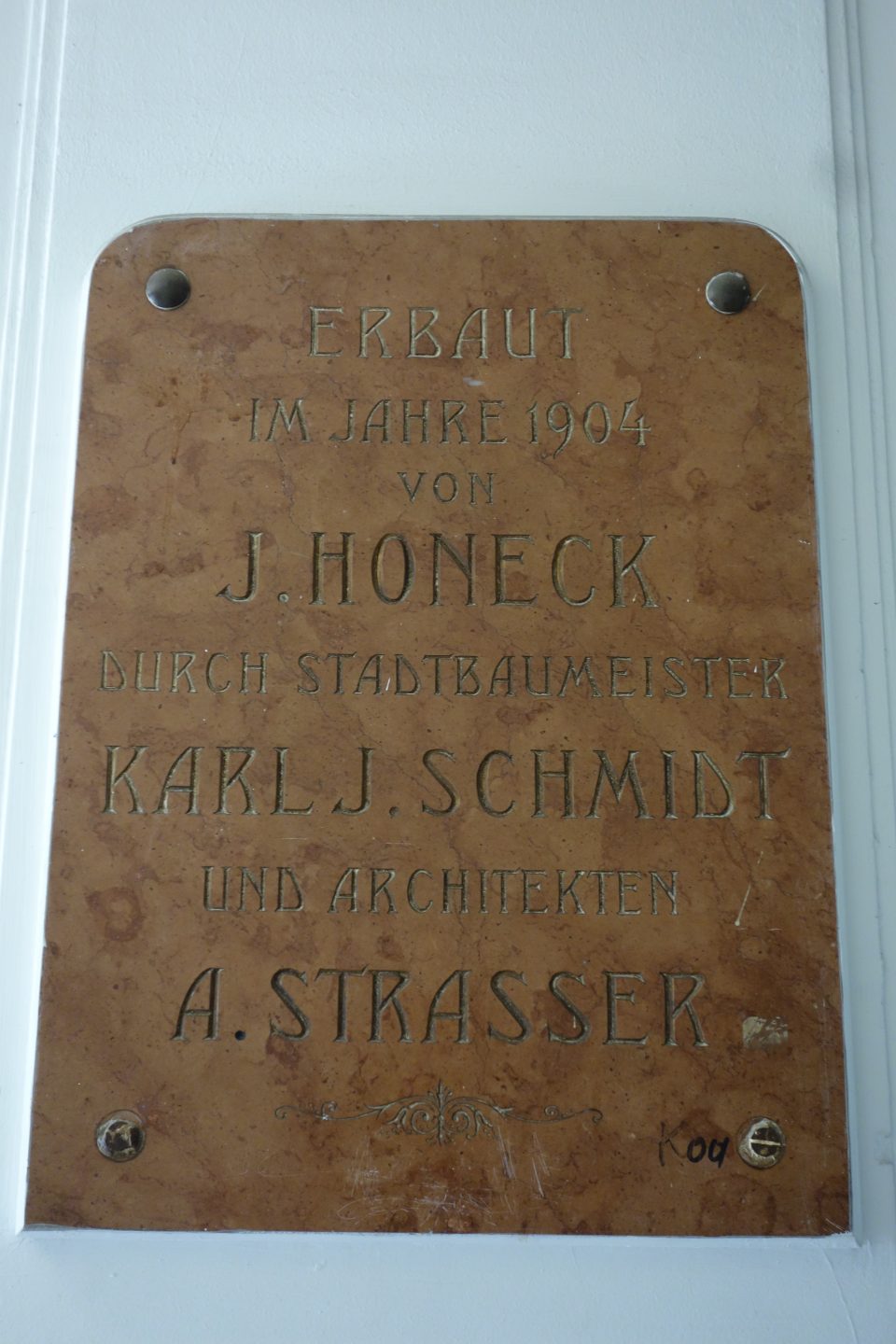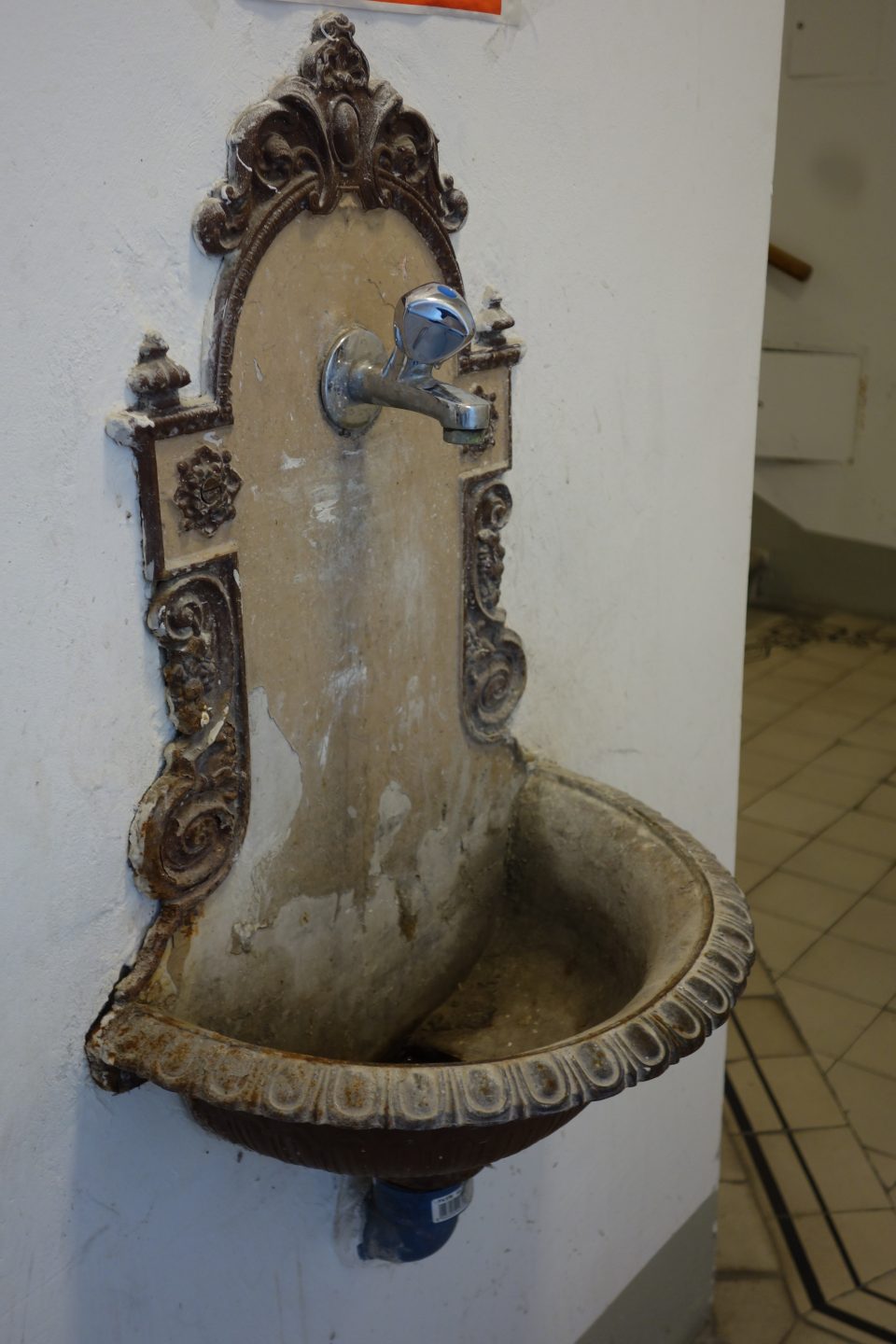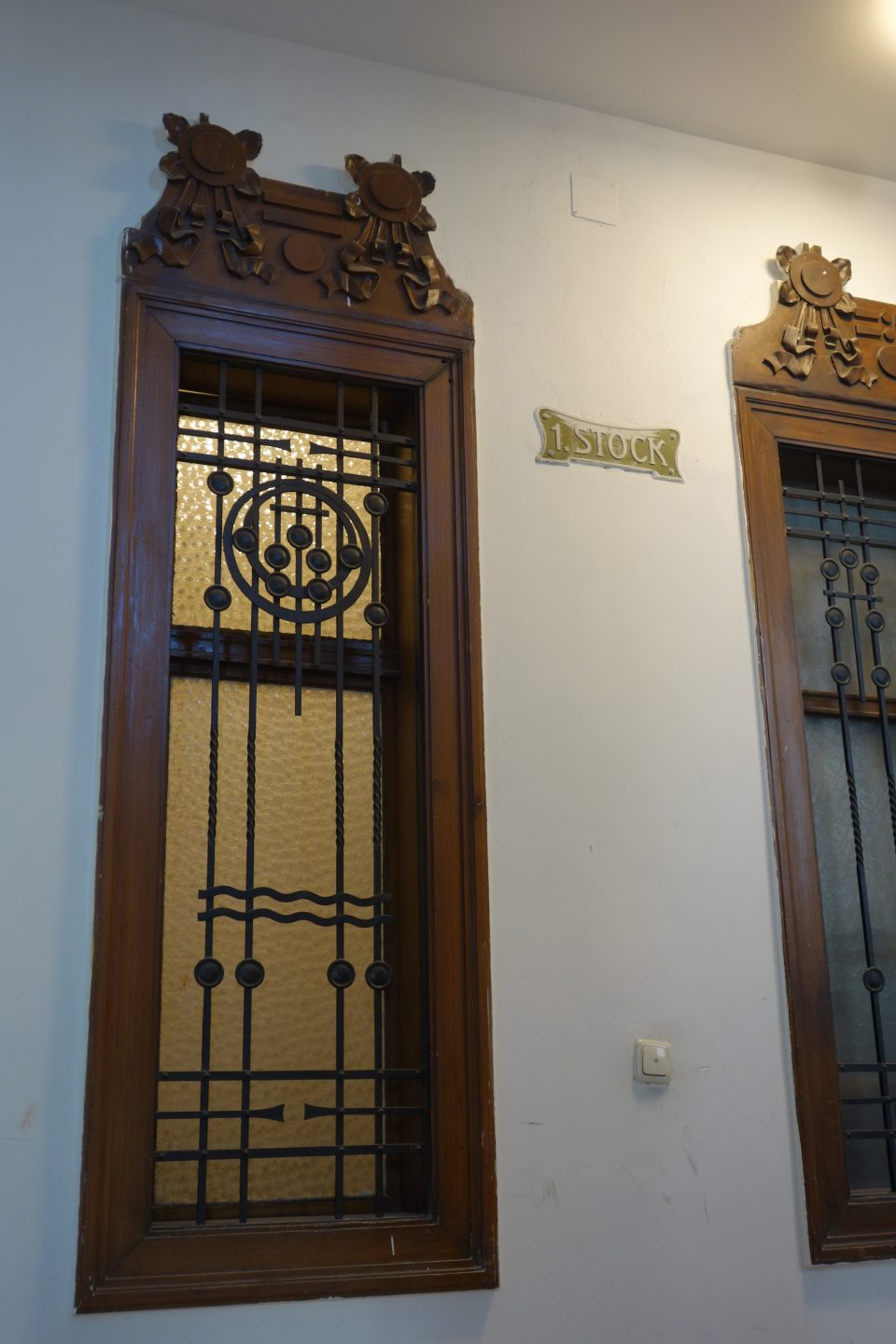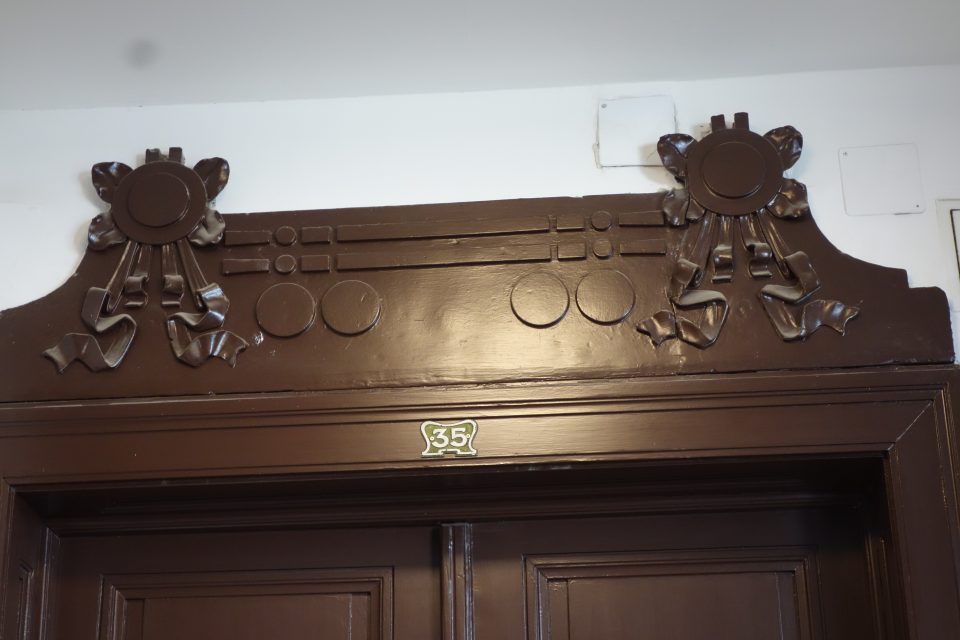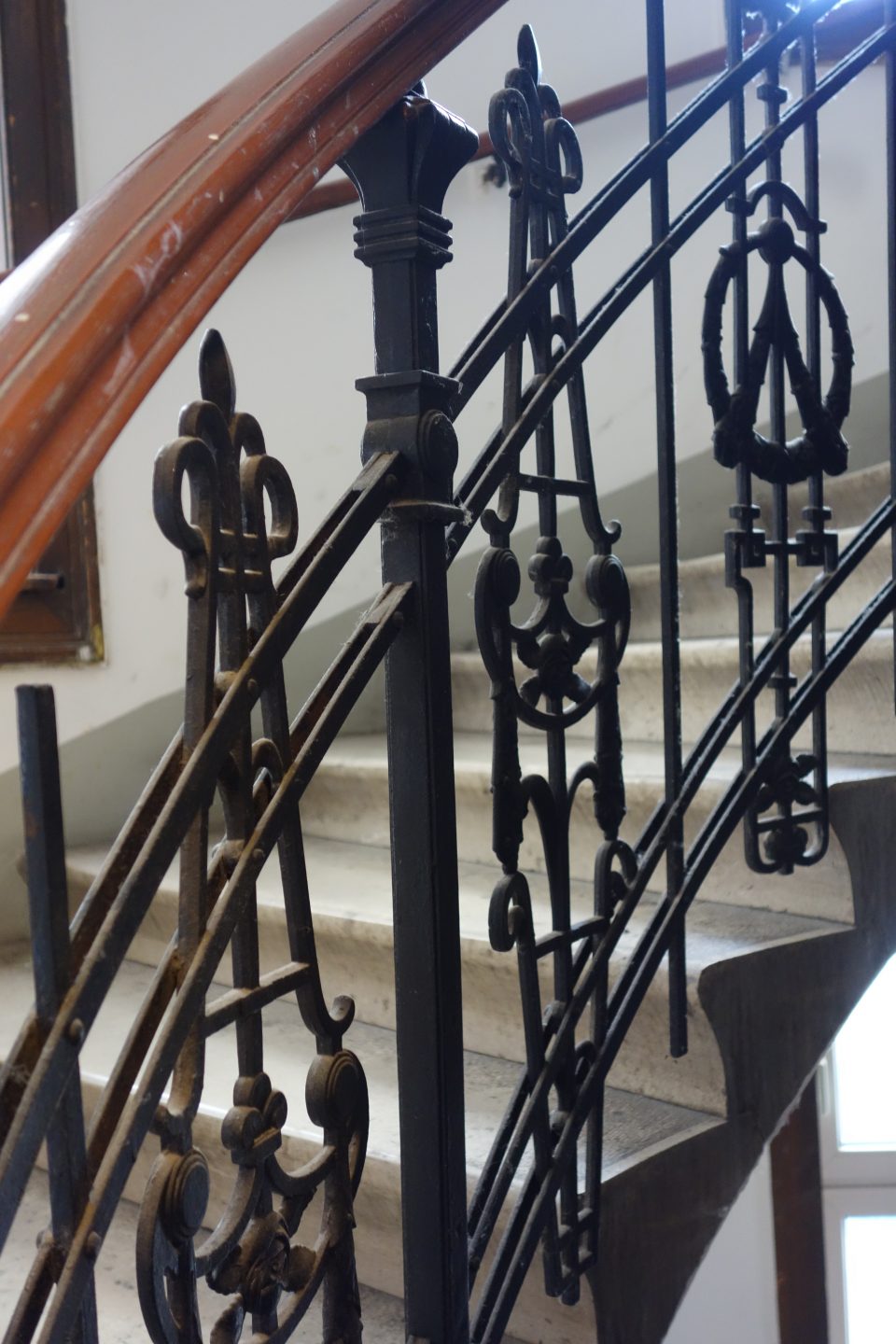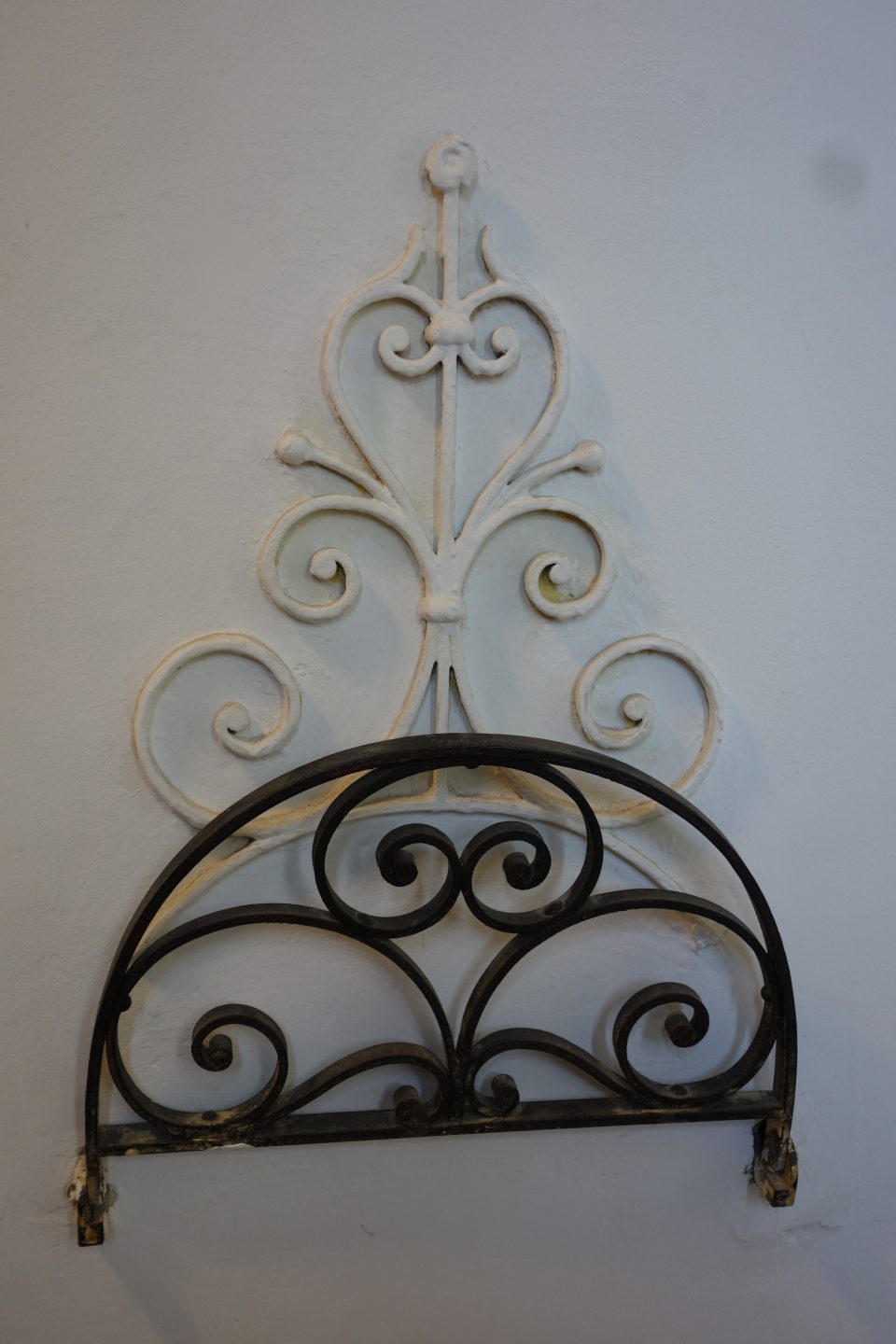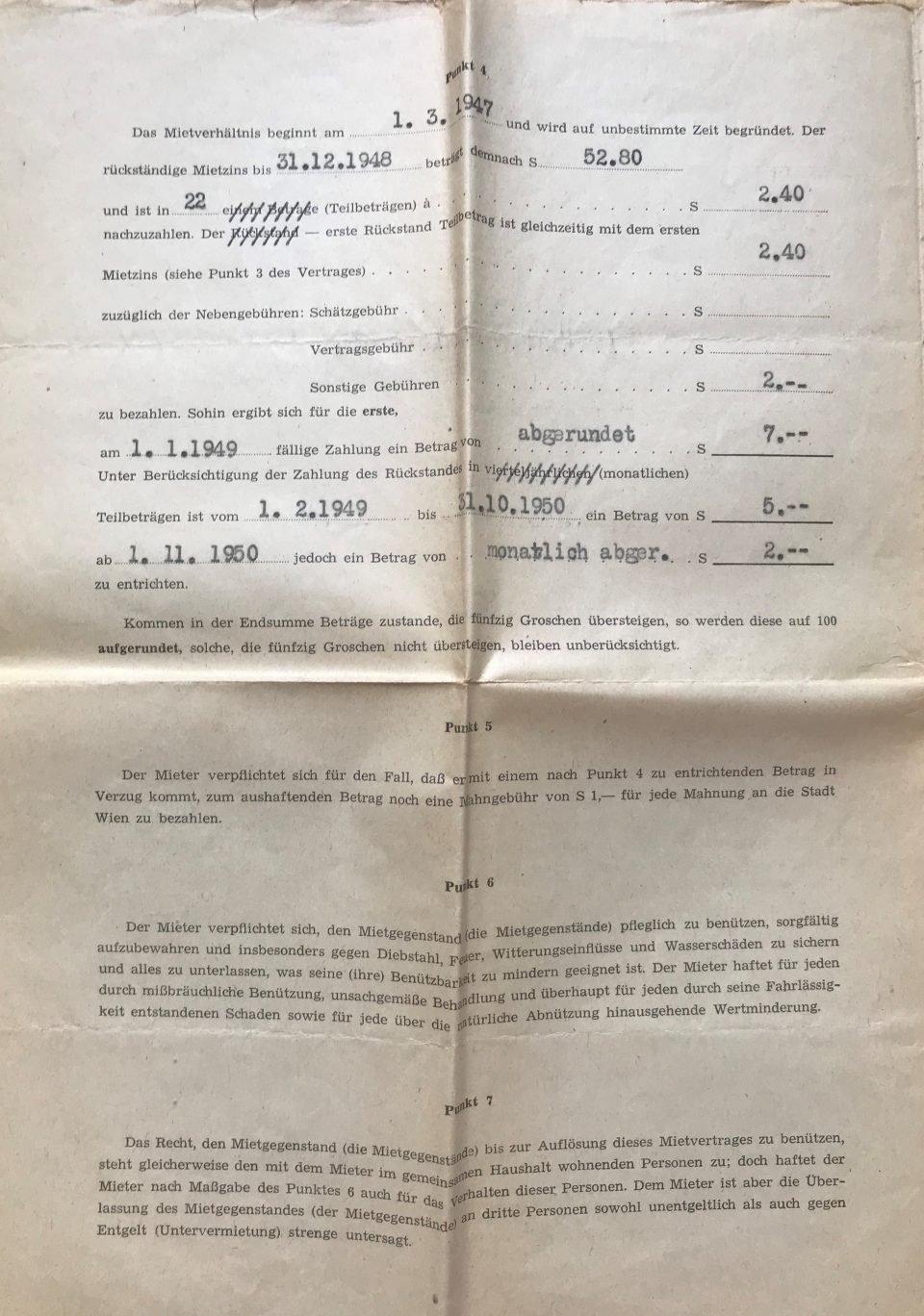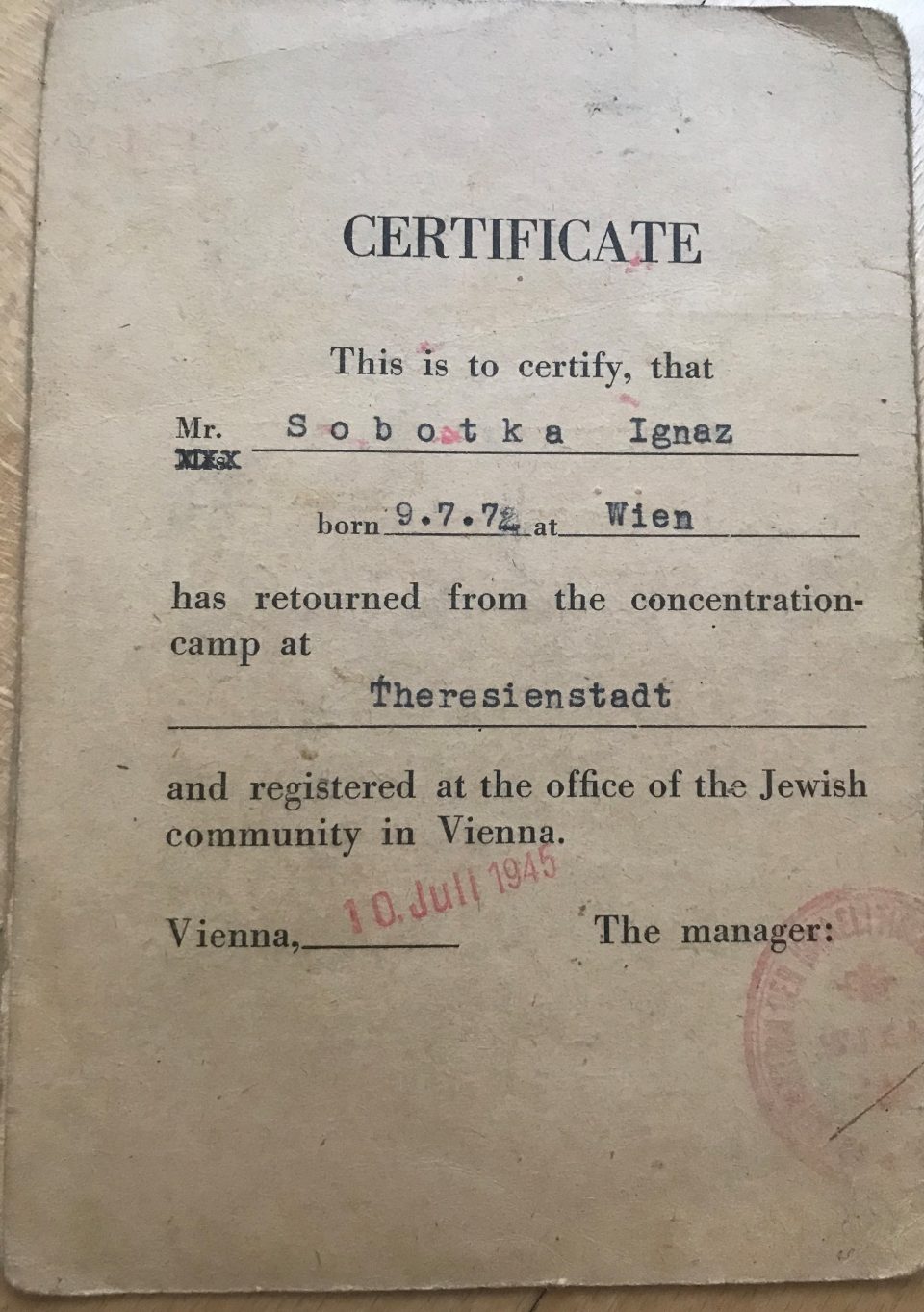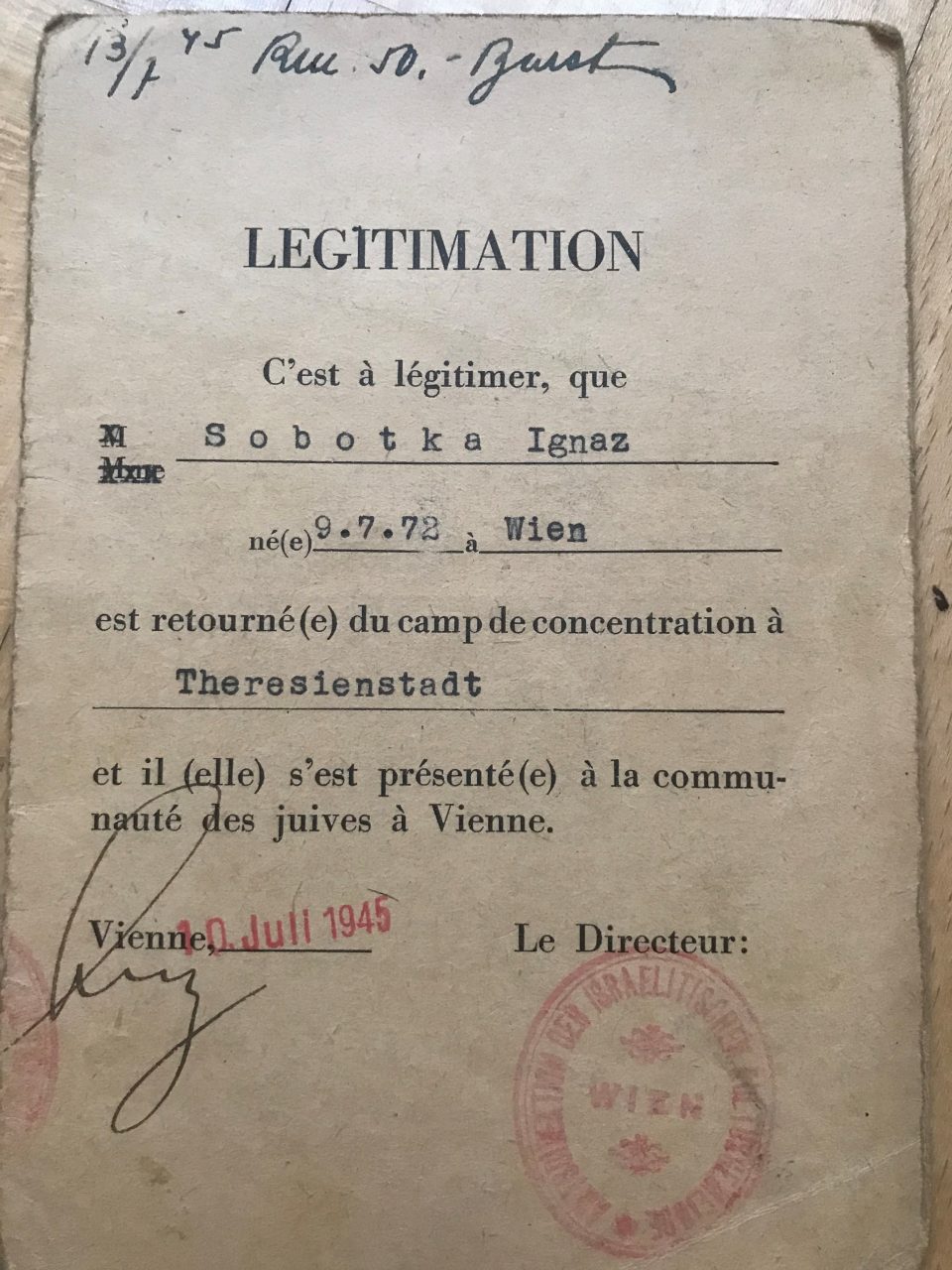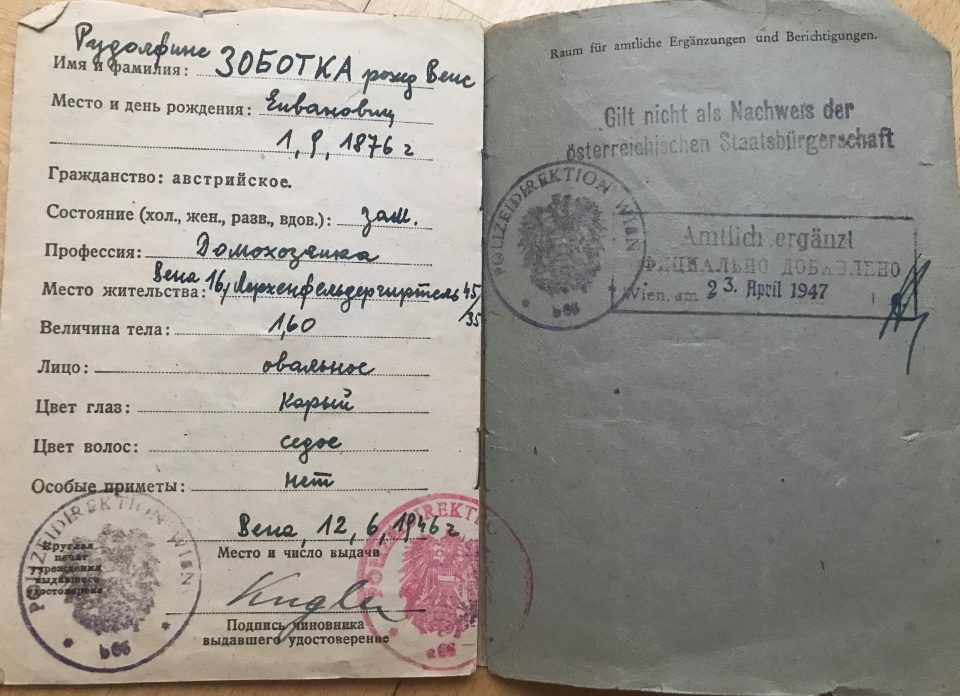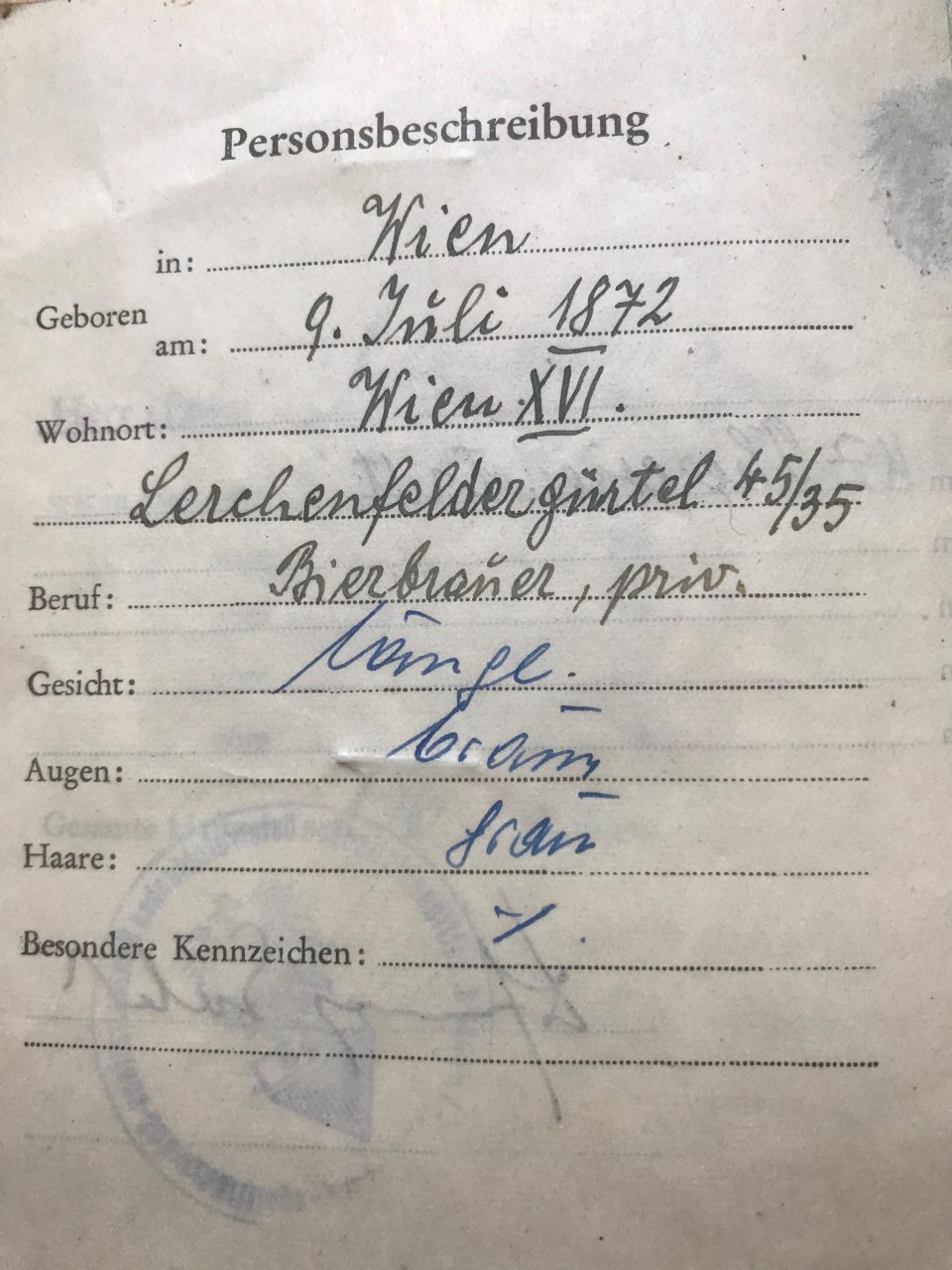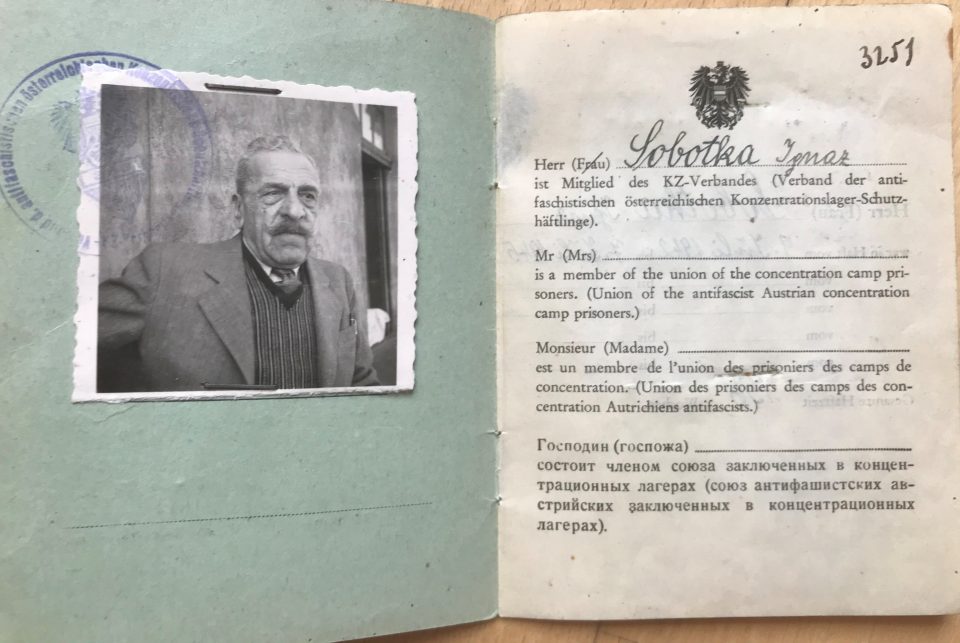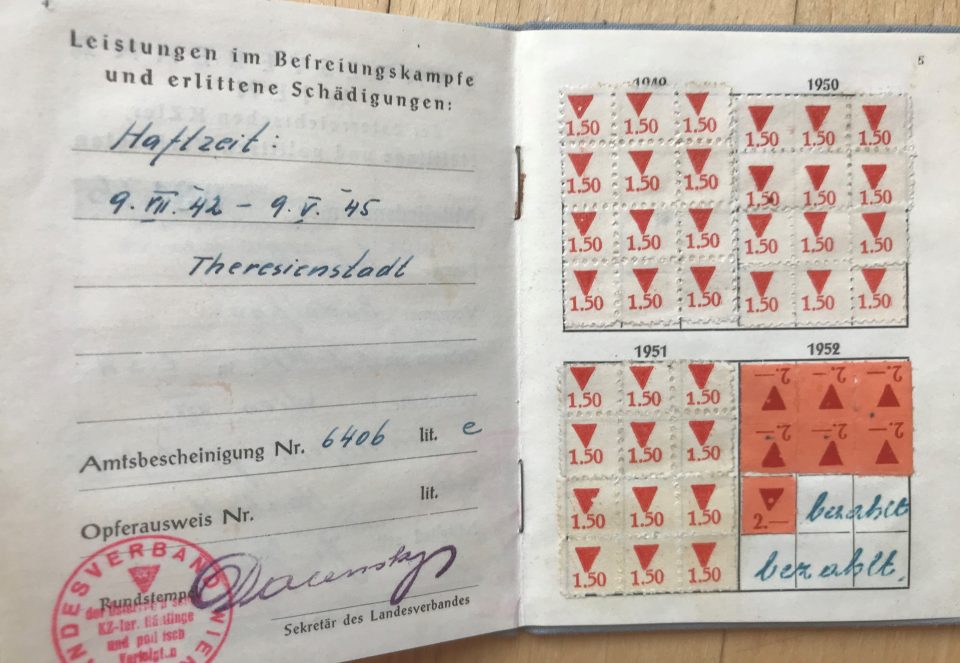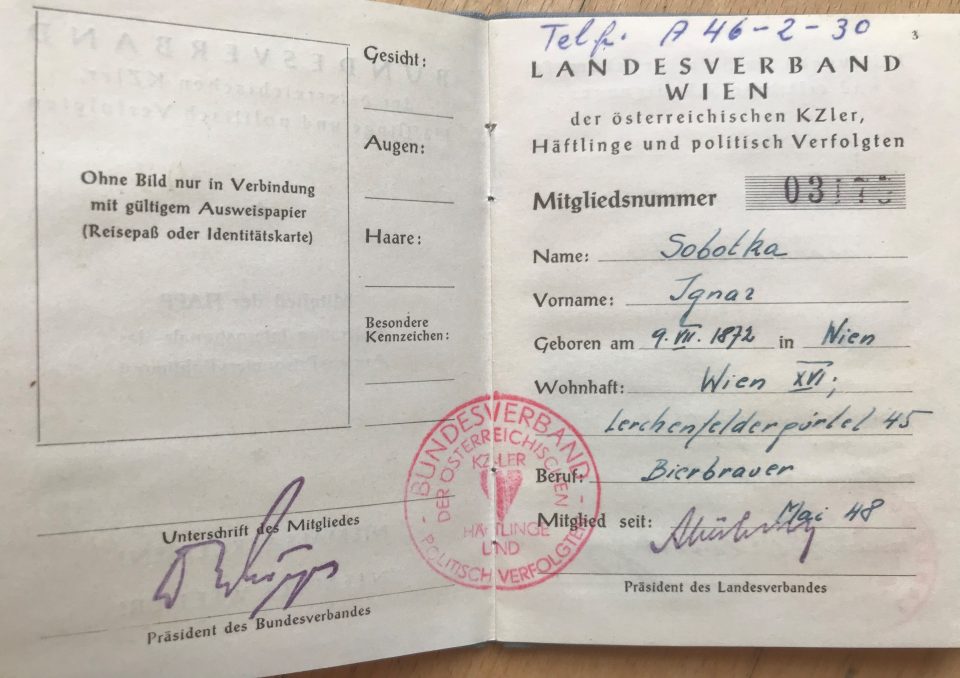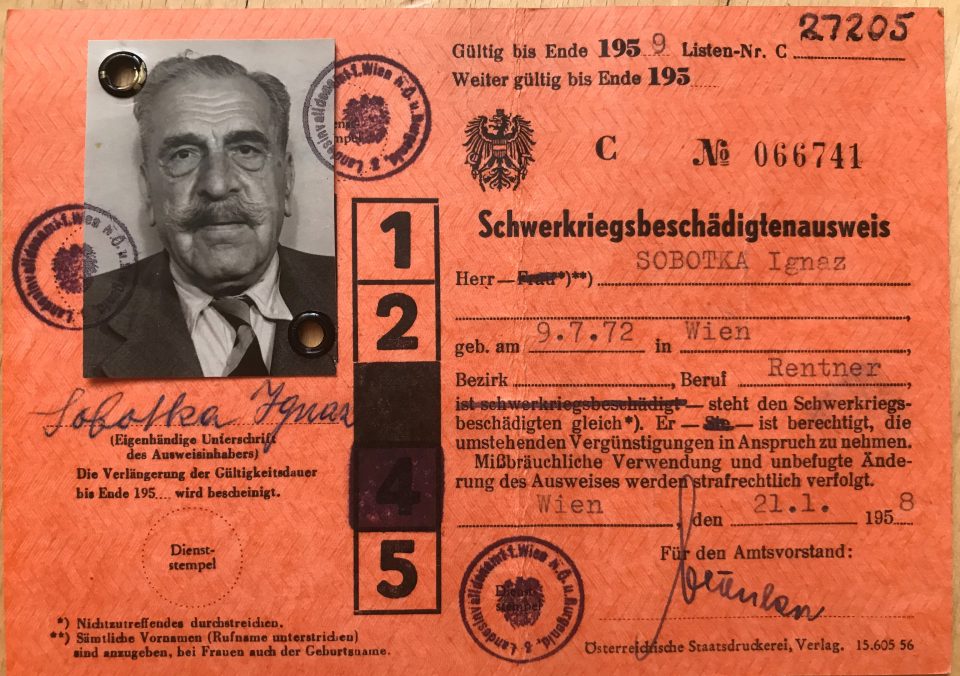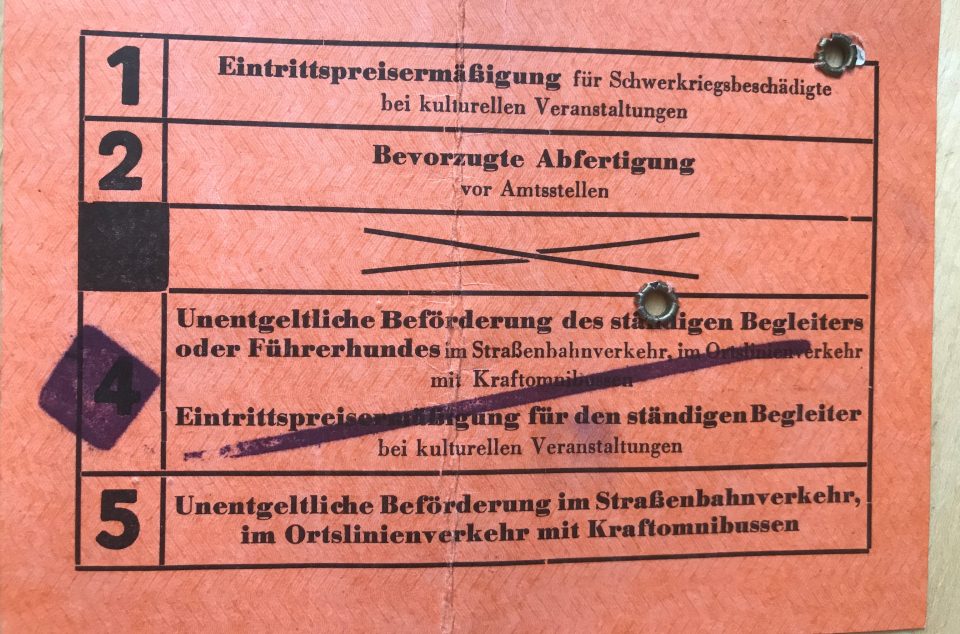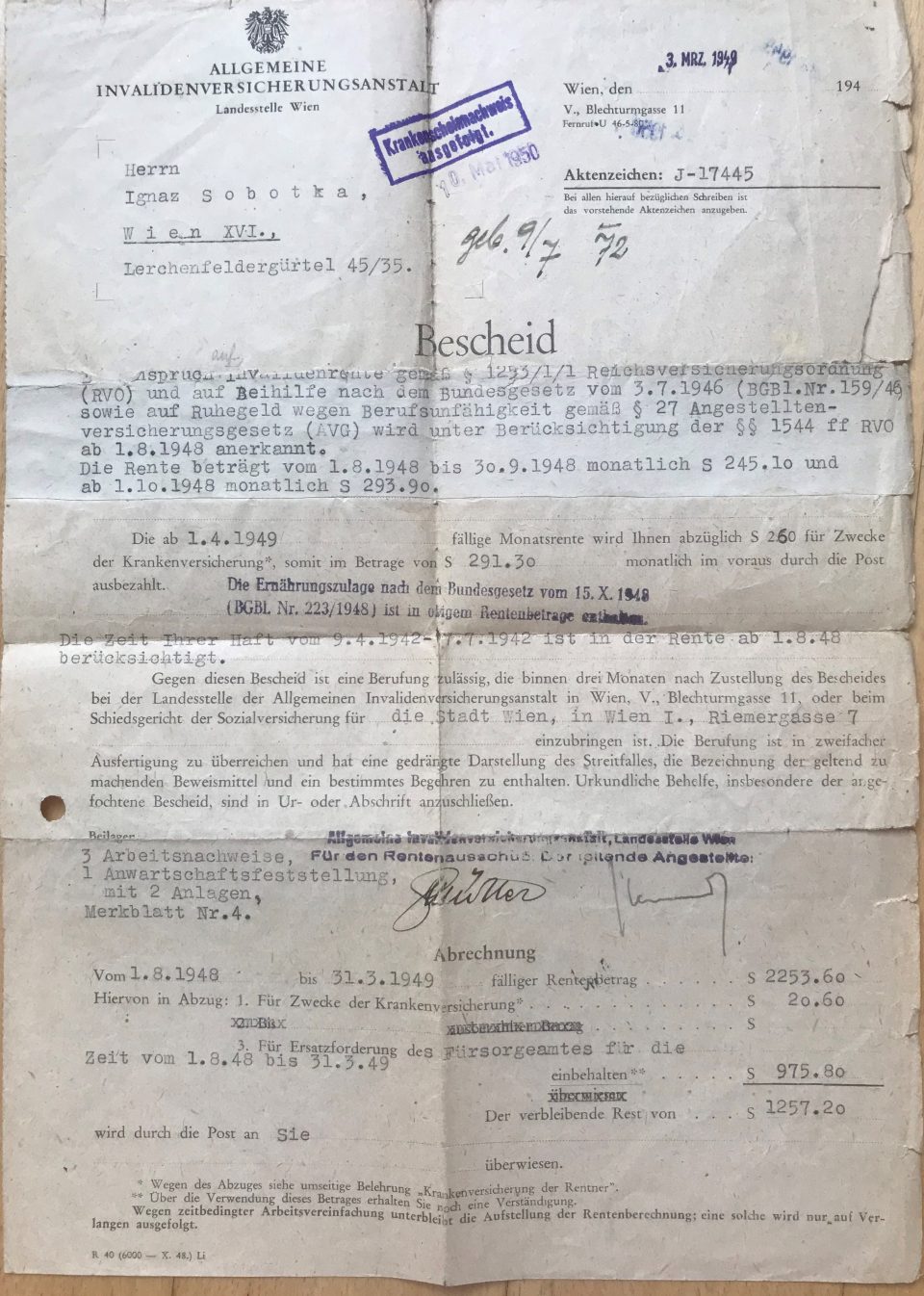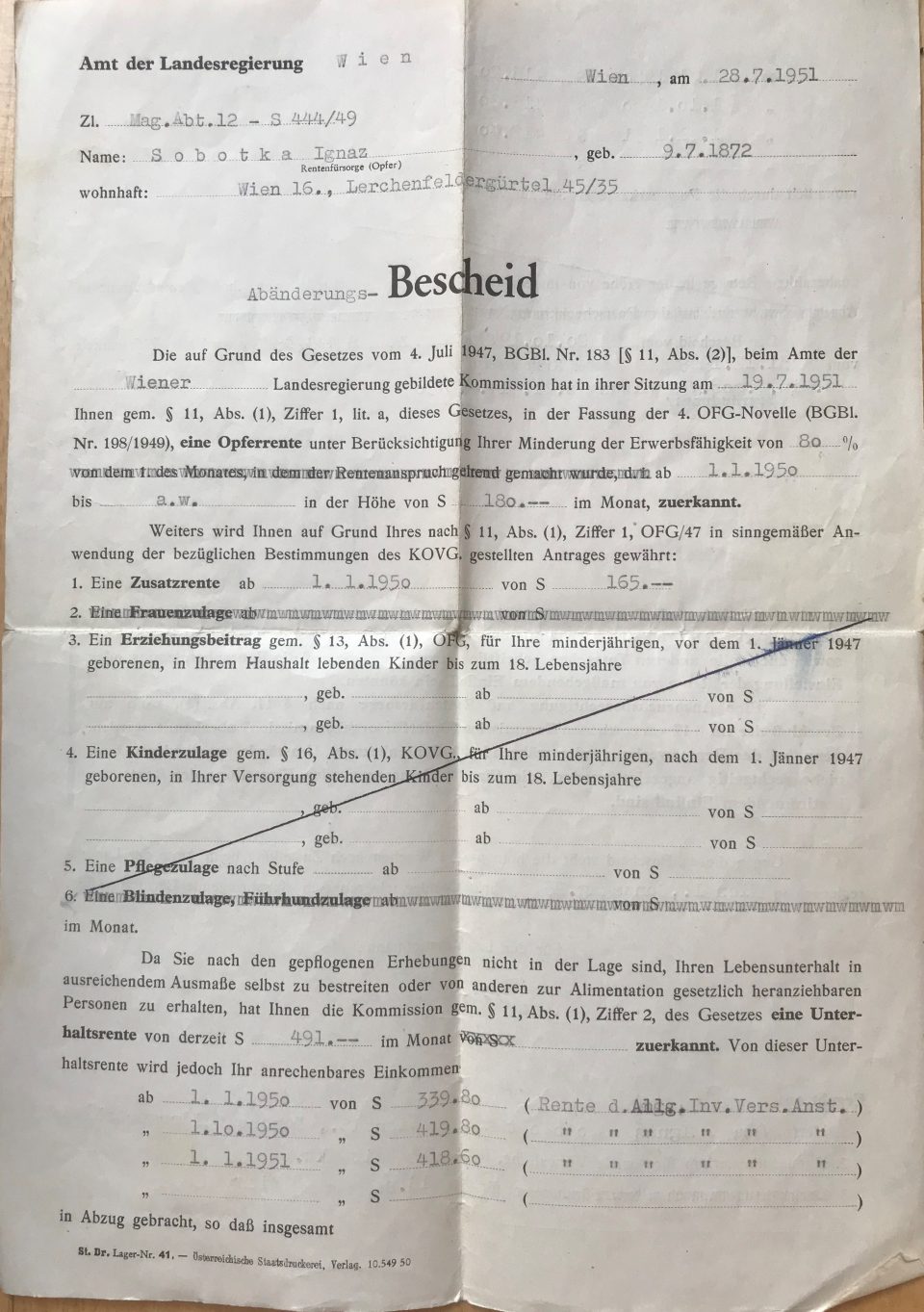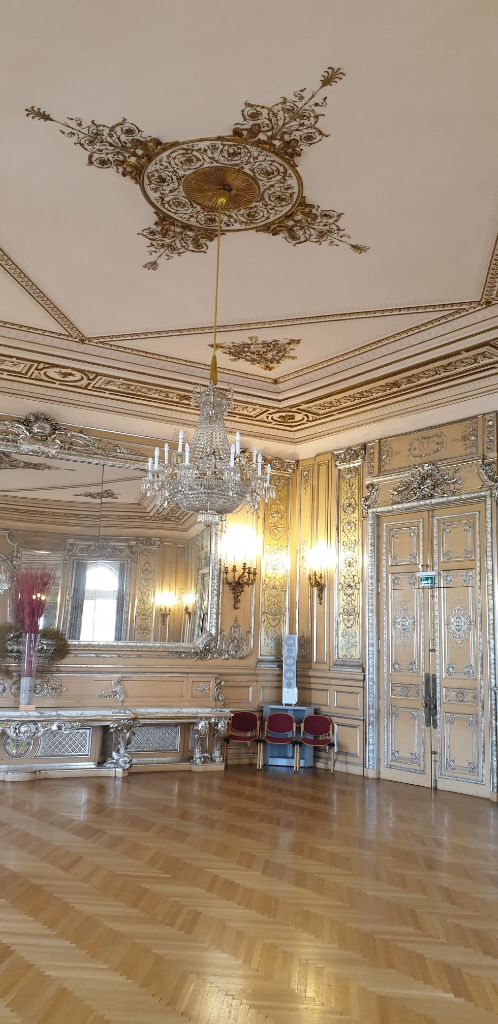Between 1942 and 1944 the Nazis constructed three pairs of “Flak Towers” in the 2nd, 3rd and in the area of the 6th/7th district in Vienna, which are still present in the city scape today as an ugly warning against war. They were erected to attack Allied bombers, but were rather inefficient. Only two of them have found a new purpose nowadays, one as a depot for art and the one below as a climbing wall and aquarium (“Haus des Meeres”).
These “Flak Towers” were also used as bomb shelters in 1944/45 and my grandmother Lola and my mother Herta only once sought refuge in this tower in Esterházypark near their flat in Mariahilferstrasse 41, but the crowded atmosphere there so much frightened Herta, who was 11 years old then, that they never returned and hid in the cellar of their house instead.
The “Viennese Diary of 1944/1945” by Josef Schöner (1904-1978) offers a personal impression of the life in the city of Vienna during the last days of the war and the months after the liberation of the city by the Soviet Red Army. Schöner was an Austrian diplomat who had been dispatched to the United States and was forcibly retired by the Nazis in 1939 after the “Anschluss” (the Nazi takeover of Austria). During the war he worked in the restaurant business of his parents and was called back to diplomatic service after the end of the war. The experiences of my grandparents, Lola and Toni Kainz, and their daughter, Herta, my mother, are an important source of information about life in Vienna during the last months of the 2nd World War and the time after liberation. My great-grandparents, Ignaz and Rudolfine Sobotka, in the photo below with Lola, their daughter and Herta, their granddaughter, returned from the Nazi concentration camp Theresienstadt to Vienna in the summer of 1945, but they never talked about their experiences during their imprisonment.
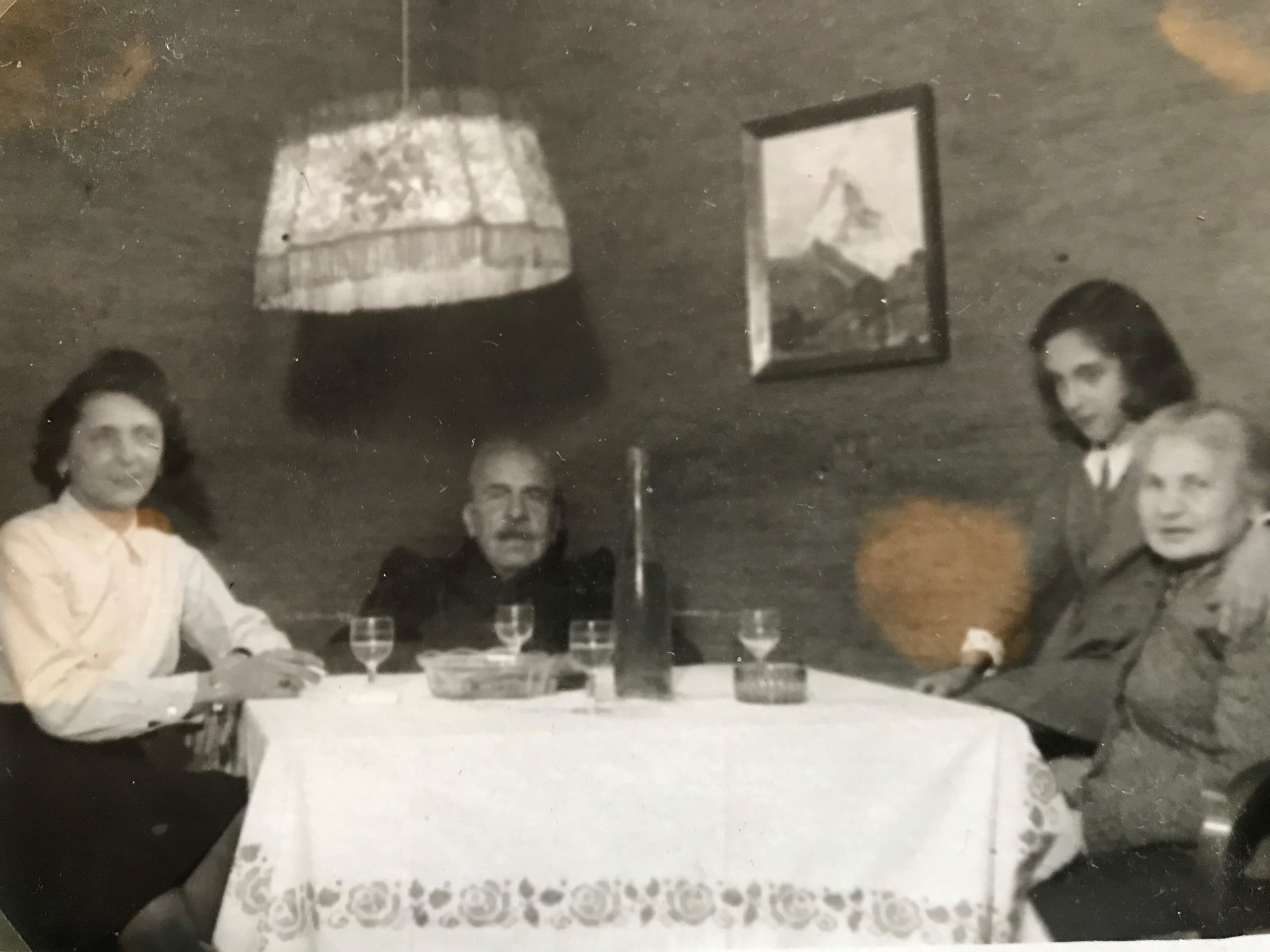
Ignaz and Rudolfine Sobotka with their daughter Lola (left) and their granddaughter Herta (right) after their return from the KZ Theresienstadt in the small flat of Lola and Toni in Mariahilferstrasse 41
Ignaz and Rudolfine Sobotka with their granddaughter Herta (and with Lola and Toni) on the balcony of the bigger rented flat in Lerchenfeldergürtel 45, which was allocated to Ignaz and his family after their liberation from the KZ Theresienstadt
This article furthermore deals with the way restitution worked for the victims of Nazi persecution after the war, focussing on the non-elite who had survived Nazi concentration camps and the ordinary Viennese citizens of Jewish descent who returned from exile. The overall number of those who came back to settle in Austria again was embarrassingly small: only 6 per cent. This can be explained by the fact that they were not at all welcome in post-war Austria.
The decision of the Allied Forces in 1943 to insist on “unconditional surrender” of Germany implied that Germany would have no say at all in the new world order after the end of the 2nd World War. The Allies then started to discuss the destiny of the many small states which had been incorporated into the Nazi “Third Reich”. Austria was just one of them and certainly not the most important one. A new order in Central Europe was considered important because it had become apparent that the Western inter-war policy of the 1920s and 1930s had failed in the region. The British were the first to weigh the pros and cons of four different options for Austria after the end of the war. First, Austria could become an independent state as between 1918 and 1938; second, it could remain in a union with Germany; third, Austria could be part of a new, not yet clearly defined “Danube Confederation” or fourth, Austria could be split up and the western part would join Germany or Switzerland and the eastern part the “Danube Confederation”. But the Soviet Union had its own interests in the Central European region and Stalin insisted on the restoration of an independent Austrian Republic. The British wanted to boost the resistance among the Austrians against the Nazis and made that a condition for a preferential treatment of Austria after the victory over Nazi Germany. They were certain that Austria had to rely on massive foreign aid to survive as an independent state and that’s why they preferred a “Danube Confederation”. But the Soviets were strictly against any form of a Central European confederation of states. At the same time there was no clear strategy visible in the USA and the British did not want to alienate either the Americans or the Soviets. In a draft of July 1943 Austria was declared the first free country which had been a victim of Nazi aggression and the decision how Austria would be treated in future would depend on the behaviour of the Austrian people, who were responsible for the war, too. The “Anschluss” was imposed on Austria and was therefore null and void. In order not to become a basis for German aggression again in future Austria was to be restored as an independent state. Already in this draft the responsibility of the Austrians for the war was deliberately expressed in an ambiguous way. At that point in time also the governments of the Commonwealth countries discussed the destiny of small European states like Austria and the South-African Prime Minister Jan Smuts vehemently opposed a promise to Austria that it could expect preferential treatment to Germany and he further rejected the idea of promising independence to small states which were economically too weak to survive. He pleaded for a South German state, which would achieve two goals, namely a breaking up of Germany and the integration of Austria in a state with Bavaria. This was a solution which did not please the British Foreign Office under Anthony Eden who preferred a Central European Confederation and refused to offer preferential treatment to Bavaria, the region of origin of National Socialism. The Soviet Union pleaded for the Austrian independence and stated that they would not expect Austria to come under the Soviet sphere of influence. Interestingly, the Soviets did not want to stress Austria’s responsibility for the war.
Finally on 1 November 1943 the “Moscow Declaration” confirmed that Austria was the first victim of Nazi Germany and would be restored as an independent republic once Hitler was defeated. At that point in time it was not to be predicted of how great the importance of this document would be for the future of Austria in 1945. Despite its ambiguity this declaration is the most important document for Austria before the State Treaty of 1955. The “Moscow Declaration” must have been known in Austria in November 1943 because the Nazi newspaper, the “Völkischer Beobachter”, reported about it. In conclusion it can be said that the British had invested much more thought in the future of Austria than any other of the Allied partners. They now started to plan the zones of occupation after the war and were prepared to offer the whole of Austria to the United States because their projected zone of occupation in southern Germany was rather small. But the Soviets insisted on a joint occupation of Austria by the Soviets, the Americans and the British. During this time of strategic planning, the war continued and the destruction of the German and Austrian cities and infrastructure was stepped up by Allied bombardments. In the spring of 1944 the south of Austria had come under attack of Tito’s Communist Partisans from the south. In September 1944 Churchill and Roosevelt agreed on the zones of occupation for Germany and the Soviet, British and American diplomats came to an understanding that the one who reached Vienna first, would invite the other two Allies to join in. On 31 October 1944 the British stipulated what should happen in case Austria was reached by the Allied troops before the unconditional surrender of Germany. Most importantly these directives included a warning that Austria could not escape its responsibility for the participation in the war and that it would be held accountable. Yet the degree to which Austrians contributed to the liberation of their own country would be taken into account. This proclamation stated that the British considered Austria an enemy state because Austria was waging a war against the Allies and that’s why the British considered themselves as victors and not liberators. The Soviets wanted to occupy the Burgenland and the eastern parts of Lower Austria and Styria and a third of the city of Vienna. The Americans expected that their zone of occupation in Vienna included an airfield. Basically, the Americans and the French had no special interest in occupying parts of Austria. Their focus was on Germany, but they accepted the British invitation to participate in the occupation of Austria.
The next important issue were the reparations the Allies demanded from Austria. This was the question that also interested France and the French justified their demands with the argument that Austria had taken away lots of factory equipment from the occupied territories during the campaign against France. It was agreed that the future independent Republic of Austria was liable for the share Austrians had had in the war, the deportations and the dismantlement. At that point in time – January 1945 – the Allies did not yet mention the involvement of Austrians in the holocaust. The Americans wanted to restore Austria and did not want to risk its economic survival, of which they were not convinced anyway, by reparation demands. But the whole question of how to deal with Austria was still unsolved in February and March 1945, much to the regret of the British. In fact, since the middle of March the Red Army was approaching Austria unstoppably. The British war minister Sir James Grigg noted that Vienna was the key to the whole Austrian situation, just as Berlin was in the case of Germany. In the “Battle of Vienna” the Red Army seized Vienna and dictated the situation. So the Soviets felt no longer bound by any preliminary Allied agreements.
The end of the 2nd World War in Austria was no real “awakening”, but a kind of “backward disruption”, as the Viennese diplomat Josef Schöner called it. Some of the old élites felt that they just could continue from where they had left off in 1938, when “a madman (Adolf Hitler) had disrupted” their political and social system, as the writer Alexander Lernet-Holenia put it. But also the ideology of the “Third Reich” did not just dissolve from one day to the next and left many behind who were indoctrinated by Nazi ideas. Yet in large parts of the Viennese population the excessive and radical politicization of the young via Nazi youth organisations, such as the “Hitlerjugend” (for boys) and the “Bund deutscher Mädchen” (for girls) had created a sceptical and disoriented young generation. This did not facilitate the transition to democracy, especially as the National Socialist ideology still pervaded the society under the surface. Examples of this very complex social fabric were strong and ongoing anti-Semitic sentiments and the “threat from the east”, namely the Soviets, both Nazi propaganda remnants. Furthermore the economic structures in Austria pointed rather back to the Nazi period than forward to a new future, whereby the rigidly planned post-war economy was still carried by a strong anti-capitalist sentiment. The myth of 1945 as the “hour zero”, the new beginning of an era of economic growth and cooperation, was deliberately disseminated to annihilate the past and the involvement of many Austrians in the Nazi terror machinery. Another myth, the spirit of the “Lagerstrasse” (concentration camps), namely the experiences of formerly hostile Austrian political leaders in Nazi concentration camps, which induced them to post-war peaceful cooperation, is not based on reality. Only very few of the post-war political leaders in Austria had been incarcerated in Nazi KZs; neither Renner nor Raab, neither Schärf nor Gruber, neither Körner nor Gleißner, all prominent politicians of the early years of the 2nd Austrian Republic, had been in concentration camps.
From an economic point of view there was even more continuity: despite the Nazi propaganda of “blood and soil” and “agrarian romanticism” the Nazi economy was geared towards technology, progress and innovation, which formed the basis for the post-war boom years. Austria had experienced one and a half years of economic upturn in 1938/39 under Nazi rule before the outbreak of the war and this development was rooted in Hitler’s gigantic, exaggerated and sometimes even grotesque industrialisation plans for his “Third Reich”. In important economic areas, such as tax law, trade law, credit law, the National-Socialist German legislation remained in place via the so-called “Rechts-Überleitungsgesetz” of 1945. An important further signal of continuity was the decision not to return to the economic structure of before 1938, but to carry on the industrial investment projects the Nazis had initiated before and during the war, such as the dam for the hydro-electric power plant of Kaprun, where my father, Werner Tautz, worked after the war. But also parts of the Austro-Fascist system of 1934-1938 remained in place, especially with respect to the economic personnel and the representatives of economic policy and industrial relations. The head of the Austrian central bank during the Austro-Fascist period, Viktor Kienböck, was appointed again in 1945. Josef Schöner complained in the face of this political decision by the Allied administration, what chances of a new awakening would Austria have, if all important positions were again “stuffed with old personnel”. The economic break-down in 1945 was as dramatic as the collapse of the Austro-Hungarian Empire in 1918, but the rebuilding of the Austrian economy after 1945 turned out to be much more successful due to wide-spread optimism among the population, a true belief in the new 2nd Republic and extensive foreign aid.
As soon as the republican constitution of 1920 was re-established by the Soviets in April 1945 the old political élites returned: Karl Renner, General Körner and Leopold Kunschak and with Leopold Figl and Adolf Schärf politicians next in line stepped into the foreground. The Austrian politicians who had been forced into emigration from 1934 on were not welcome and were not called back. Surprisingly quickly the old political players took over control in Austria and the representatives of the resistance movement, especially the O5, were eliminated or at best incorporated into the old party system. Just at the beginning the Austrian Communists, who had returned from exile when the Soviets liberated Vienna, played a minor role as a democratic party in the east of Austria. Strangely, the Soviets sometimes supported and then again obstructed the work of the Austrian Communists. The traditional German Nationalist political movement was not represented in the early days of the 2nd Republic, as all National Socialists were ousted from their positions initially. The original idea was the restauration of the 1st Austrian Republic, but the problem were the four years of Austro-Fascist rule 1934-1938 and especially the USA went for an elimination of the Austro-Fascist as well as the National Socialist elements of the Austrian society and political system. But it quickly turned out that the vast majority of the Austrian Conservative Party (ÖVP) had been in some way involved with the Austro-Fascist dictatorship and were targeted by the Nazis in 1938. So they could be considered victims of the Nazi regime after 1945. Consequently this period of Austrian autocratic rule was not in any way tackled, much to the regret of the Austrian Social Democratic Party (SPÖ), which had been banned by the Austro-Fascists in 1934. Despite outward signs of cooperation, the lingering animosity between the two main political factions, the Conservatives of the ÖVP and the Social Democrats of the SPÖ persisted throughout the after-war years. The dividing lines ran through families like mine. Toni Kainz, my grandfather, was the son of bourgeois Viennese innkeepers and a strong supporter of the Conservatives, just as my father Werner Tautz, his son-in-law. My grandmother, Lola Kainz and her whole family, who were of Jewish descent, were Social Democrats. There ran a joke in the family: Whenever there were elections Toni challenged my great-grandfather, Ignaz, whether he was sure that he had ticked the right box on the ballot paper and Ignaz was always anxious that he had not voted for the Social Democrats. The foster father of my father, Franz Rupp, had been a Nazi and had turned into a fervent Social Democrat after the war, which shows that both Austrian main parties recruited their supporters and voters from the pool of former Austro-Fascists and Nazis, too. Despite the commitment of both ÖVP and SPÖ to prevent another civil war at all costs, the emotional scars that separated the Conservatives from the Social Democrats were deep and never forgotten. But the harsh after-war reality and the pressure from the occupying Allied Forces helped to overcome certain political barriers in order to achieve a common goal, namely the reconstruction of the country’s economy and the establishment of an independent Austrian state and the withdrawal of the Allied troops, which was achieved ten years later in 1955.
The system of “Proporz” (proportional allocation of resources and positions in the 2nd Austrian Republic between ÖVP and SPÖ) characterised this period. Important cornerstones of the post-1945 political development in Austria were the withdrawal of the Catholic Church from politics, largely thanks to the liberal Cardinal Franz König, and the drastic loss of appeal of Marxism due to the experiences the Austrians, especially in the east, made with the Soviet system and the Soviet soldiers. Furthermore the Nationalists’ dream of uniting Austria with Germany was ended for good and official Austria celebrated and disseminated the myth of “Austria as the first victim of Nazi Germany”. Everything “German” was taboo and all the blame and the responsibility for the Nazi atrocities, war crimes and the holocaust was put on the Germans; by that ignoring the decisive share Austrians had had in the extermination machinery. An Austrian patriotism was imposed from above, covering up historical facts and hiding the truth. Interestingly enough, the Conservatives, the Social Democrats and the Communists worked together in this cover up of the Nazi history of Austrians and the Allied administration looked on. On 11 April 1945 Josef Schöner visited the Palais Auersperg, which had been the headquarter of the Austrian resistance movement against the Nazis, and noted sarcastically that the “Styrian hat” had become the old and new “uniform”, a uniform that was to represent the new Austrian patriotism, but had been used as camouflage by the Nazis as well.

Palais Auersperg, the headquarter of the Austrian resistance movement O5: In 1944/45 the resistance fighters, who planned sabotage acts, hid there; they were young men of the former Austrian nobility and bourgeoisie under the command of Major Carl Szokoll, for example Willi Thurn und Taxis, the editor and journalist Fritz Molden and Adolf Schärf, later a President of Austria. This upper-class background might have been the reason why the Soviets broke up the movement, although the resistance movement O5 had negotiated in April 1945 with the Allied Forces the peaceful handing over of Austria. From autumn 1944 they had painted O5 signs on the walls of houses and churches. The medical student Jörg Unterreiner had invented the sign (O+5th letter of the alphabet E= OE=Ö for Österreich). At the façade of St. Stephen’s cathedral the sign is still visible. The Allied military police later used the Palais Auersperg as its headquarter.
In 1945 the immense devastation and destitution, the threat of a famine catastrophe, the lack of housing, hundreds of thousands of refugees and the need of establishing a functioning administration had priority over the elimination of the Nazis from Austrian society. This led to the fact that the social, legal and economic fabric was not undergoing any remarkable change. The upheaval that had taken place during the Nazi era seemed to have had more lasting effects on the modernisation of the industrial structure and the reorganisation of the society than the awakening of 1945, which showed strong restorative traces. Nevertheless, in public the Nazi ideology and rule were utterly discredited leaving not just material but societal and emotional devastation behind.

“Gstettn” in Vienna: from 1944 on the city was full of such wasteland caused by Allied bombardments, which was an ideal playground for the children of the time
Few cities in Europe had experienced similar disastrous upheavals of their economic, social and cultural foundations within a quarter of a century as Vienna. First, the breakdown of the Habsburg Empire after the First World War in 1918 and then the integration into the “Third Reich” and the collapse after the Second World War in 1945, when Austria was again torn out of a large economic area. The economic disaster in 1945 was much more dramatic for Vienna because the city was limited to the supply in its vicinity and the transport of goods and persons had broken down completely. An important part of its population, the Jewish Viennese, had either fled the city or was murdered in the holocaust. They had constituted a significant element in the economic and intellectual élite of Vienna and of the working class, too. The extent to which the city was destroyed by the war was immense, although the ultimate catastrophe was prevented by handing over the city centre to the Soviet Red Army at the last moment. The former capital city of the Austro-Hungarian Empire of 55 million inhabitants had been reduced to the status of a German provincial town of the “Third Reich” in 1938, serving the purposes of Hitler’s war economy and suffering under Hitler’s strong aversion against the city, which had “rejected” him. Now in 1945 it was an outpost of the “Western World” in the east and at the front line of the Cold War between the West and the Soviet Union. The forced expropriation of Jewish possessions and the “aryanisation” processes had been most excessive in Vienna and did not only serve ideological anti-Semitic objectives, but the aims of individual personal enrichment and the integration of the Austrian economy into the colonial system of Nazi Germany’s war economy. The complete break-down of the NS economic system and the war destructions had lasting effects on the Viennese economy way into the 1950s.
How was Vienna liberated? From the 6th April 1945 on the Soviet Red Army approached from the western Vienna Woods and was supported by approximately 13,000 renegades of the German “Wehrmacht”, forced labourers and freed prisoners-of-war, who were hiding in the Viennese allotment gardens in this area. Viennese women convinced soldiers of the “Wehrmacht” to desert from the army and provided them with civilian clothing and hiding places. They also established the first informal contacts to the Soviet soldiers, which was life-saving for the Viennese population. In 52 bomb attacks on Vienna 8,769 people died and in the ten days of the “Battle for Vienna” 2,266 people were killed, whereby half of the bodies could not be buried immediately. 85,468 Viennese soldiers were in POW (prisoners-of-war) camps. By the end of 1946 their liberation and transport home was organised, except for those who were imprisoned by the Red Army. The first POW transport from the Soviet Union to Vienna took place in September 1947 and the destiny of some Viennese soldiers was unknown for months or never uncovered. On 25 May 1947 a large group of Viennese women had demonstrated in front of the building of the Allied Commission on Stalinplatz 4 (today Schwarzenbergplatz, “Haus der Industrie”) for the freeing of the POWs imprisoned in the Soviet Union and had then marched to the Soviet Kommandatura near Bellaria.
“Haus der Industrie”, Schwarzenbergplatz 4, former head quarter of the Allied Commission
The establishment of an independent Austrian state was already decided in the “Moscow Declaration” of 1 November 1943 by the foreign ministers of the UK, the USA and the Soviet Union after Hitler’s attack on the Soviet Union had failed at Stalingrad. Hitler declared the “total war” and the “defence of Europe from the barbarians in the east”, which led to the US entry into the war and the Allied condition for peace of “unconditional surrender” of Germany. When at the Conference of Yalta in 1945 the new political order of Europe was negotiated, the Red Army was already in Budapest. This was a turning point in the history of Europe and Vienna. After twelve years of Hitler’s dictatorship and six years of war, another dictator, Stalin, decisively contributed to the liberation of Vienna and Austria. The competitive rush for spheres of influence in Europe between the Soviets and the Western Allies affected Austria to a large degree. The British Prime Minister Churchill had demanded that the Russians should not get more of Western Europe as absolutely necessary. The “Battle for Vienna” had started when on 30 March 1945 the “Reichsgauleiter” Baldur von Schirach imposed martial law on Vienna and prohibited anyone from leaving the city. On 2 April Vienna was declared a defence zone and the Soviets launched an “Appeal to the Austrians” declaring that the Soviets did not intend to acquire any Austrian territory or change the social structure of Austria. On the 7 April 1945 Hitler ordered that Vienna had to be held “until the last man” and any attempt at resistance or sabotage had to be punished with utmost brutality. Joseph Goebbels wrote into his diary that Hitler’s order was the strictest of the whole war and everyone who left his position was to be shot on the spot. He remarked that there were widespread upheavals in the “red suburbs” so that Schirach had to seek shelter among the “Wehrmacht” troops. Goebbels called for the harshest measures to “get things done properly in Vienna”. On 10 April Obersturmbannführer Skorzeny reported that the situation in Vienna was “desperate, no preparations, no commands, complete despondency; Schirach confused and without initiative, three traitor officers not shot, but hanged at Floridsdorfer bridge.” The “Battle for Vienna” lasted more than a week and according to Soviet reports 19,000 German “Wehrmacht” soldiers died, 47,000 were taken prisoner by the Red Army and 18,000 Soviet soldiers were killed. The writer Milo Dor, who had just been released from a GESTAPO prison, described the Soviet soldiers as tired and tattered and although he should be jubilant, he could just observe this sad spectacle: liberators looked different. This was probably the feeling that Lola, Toni and Herta had, who had yearned for the liberation from Nazi terror. Although they had not experienced any abuse by Soviet soldiers, rape and maltreatment by the Red Army existed. Many of the Soviet soldiers had family members who had undergone indescribable horror at the hands of German soldiers and the SS. They had been tortured, raped and murdered by Germans and now they took revenge. Eye witnesses tried to explain the excesses of and rapes by Soviet soldiers with the plundering of wine and spirits depots in the city. Viennese hospitals reported endless rows of raped women who were waiting for jabs against venereal diseases and for abortions which were legally forbidden, but carried out under these exceptional circumstances. Many Viennese had awaited the liberators, but were afraid of the Red Army. They yearned for the end of the war and the end of the bombardments. The liberation itself was witnessed differently by the Viennese depending on which side they had stood on during the Nazi period. The Nazi propaganda had stoked the fear of the Russians among the Viennese and the first experiences of pillaging, rape and abduction confirmed this anguish.
Nevertheless, at the beginning of the 2nd Austrian Republic there was the Red Army and the country started its new existence amid the tension between past and future, east and west. The Soviets declared the country of Austria as liberated, although they had only freed Vienna so far. They established Austria in the borders of 1938 and started to install an Austrian government immediately, while the western Allies only arrived in Austria a month later. When the British and Americans declared themselves as victors, half a million Soviet soldiers were already stationed in the eastern part of Austria. For Stalin it had been important to quickly extend his sphere of influence to the west and to militarily protect Czechoslovakia and Hungary and prevent any future aggression against the Soviet Union. It was surprising that Stalin appointed Karl Renner to form a provisional Austrian government, not because he was a founding father of the 1st Austrian Republic and the president of National Parliament before its dissolution through the Austro-Fascists in 1934, but because he had pleaded for the “Anschluss” in 1938. This already was a sign that the Soviets were not very committed to the idea of eradicating all Nazi elements in Austria. Stalin himself had given out the order to look for Renner and to ask him to form a government.
In the “Moscow Declaration” of 1943 the Allies had demanded a contribution of Austrians to the liberation of their country in order to compensate somehow the responsibility of Austrians for the participation in Hitler’s war against the Allies. The group of Austrian resistance fighters O5 under Major Carl Szokoll had contacted the Russians and suggested a peaceful surrender of Vienna to prevent the complete destruction of the city. The “conspirators” were betrayed and three resistance fighters were executed: Rudolf Raschke, Alfred Huth and Karl Biedermann. It is still totally unclear why the Soviets destroyed the O5 resistance movement within one week of their arrival in Vienna via order number 4 of the Soviet City Commander. Szokoll and all his fellow fighters were arrested and interrogated. Szokoll finally managed to escape from a Soviet prison. One explanation might be the rejection of any bourgeois opposition against the Nazis and the pro-Western attitude of the O5 members. Furthermore the Soviets might have wanted to claim the victory in Vienna for themselves only. How important Szokoll’s plan for the liberation of Vienna really was is unclear as well. But the dissolution of O5 has to be seen in the context of the inner-Austrian battle for the future political position, too, because the Austrian parties of the 1st Republic were re-establishing themselves in the last days of the war and they did not want any resistance fighters to take on a role in the future government. The new republic was founded on the old party systems with the blessing of the Soviets. The Communist Ernst Fischer, who had returned from exile in the Soviet Union, called the O5 fighters “naïve crooks and charlatans”. Karl Renner did not mention in a word the resistance movement O5 – although resistance was a condition which was mentioned in the “Moscow Declaration” – when he presented his provisional government consisting of the three parties, SPÖ, ÖVP and KPÖ, to Marshall Tolbuchin of the 3rd Ukrainian Front. On 27 April 1945 the Soviets issued the Declaration of Independence of Austria. On the 4th of July 1945 the 1st “Kontrollabkommen” (Control Agreement) was signed by the four Allies which stipulated the relationship between the Allied Commission and the Republic of Austria and on the 9th of July the occupational zones were fixed: the Soviet Union controlled Lower Austria, Burgenland and Mühlviertel in Upper Austria; the UK: Styria, Carinthia and Eastern Tyrol; France: Tyrol and Vorarlberg; the US: Salzburg and the rest of Upper Austria. In Vienna the city centre (1st district) was administered by all four Allies and the other districts were divided into the following zones: US: 7, 8, 9, 17, 18, 19; UK: 3, 5, 11, 12, 13; France: 6, 14, 15, 16; Soviets: 2, 4, 10, 20, 21. Toni, Lola and Herta were lucky because they lived in the 6th district in 1945, which was French, and then moved to a flat in the 16th district, which was French, too.

Lola’s ID issued by the Allied Forces in 1946
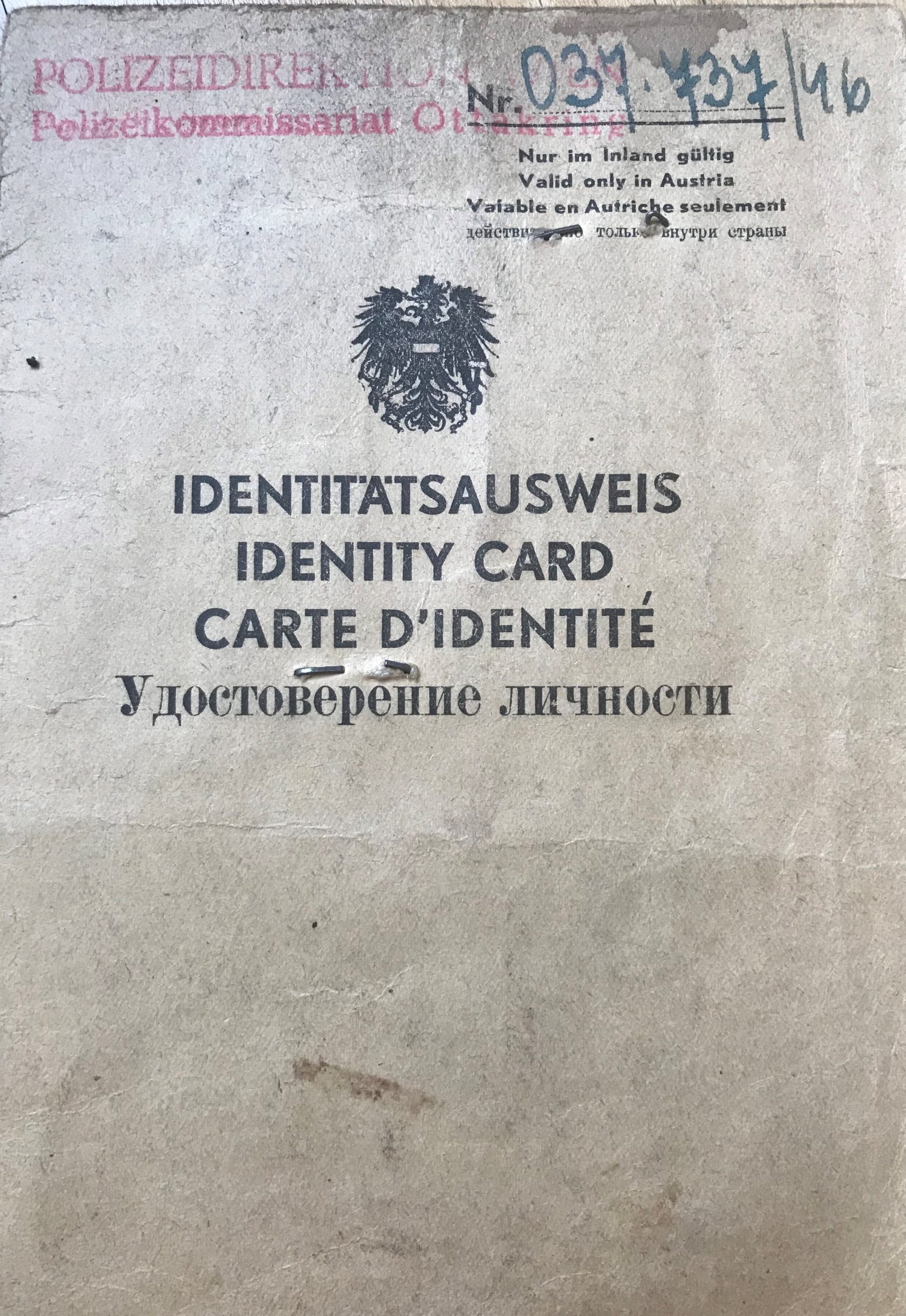
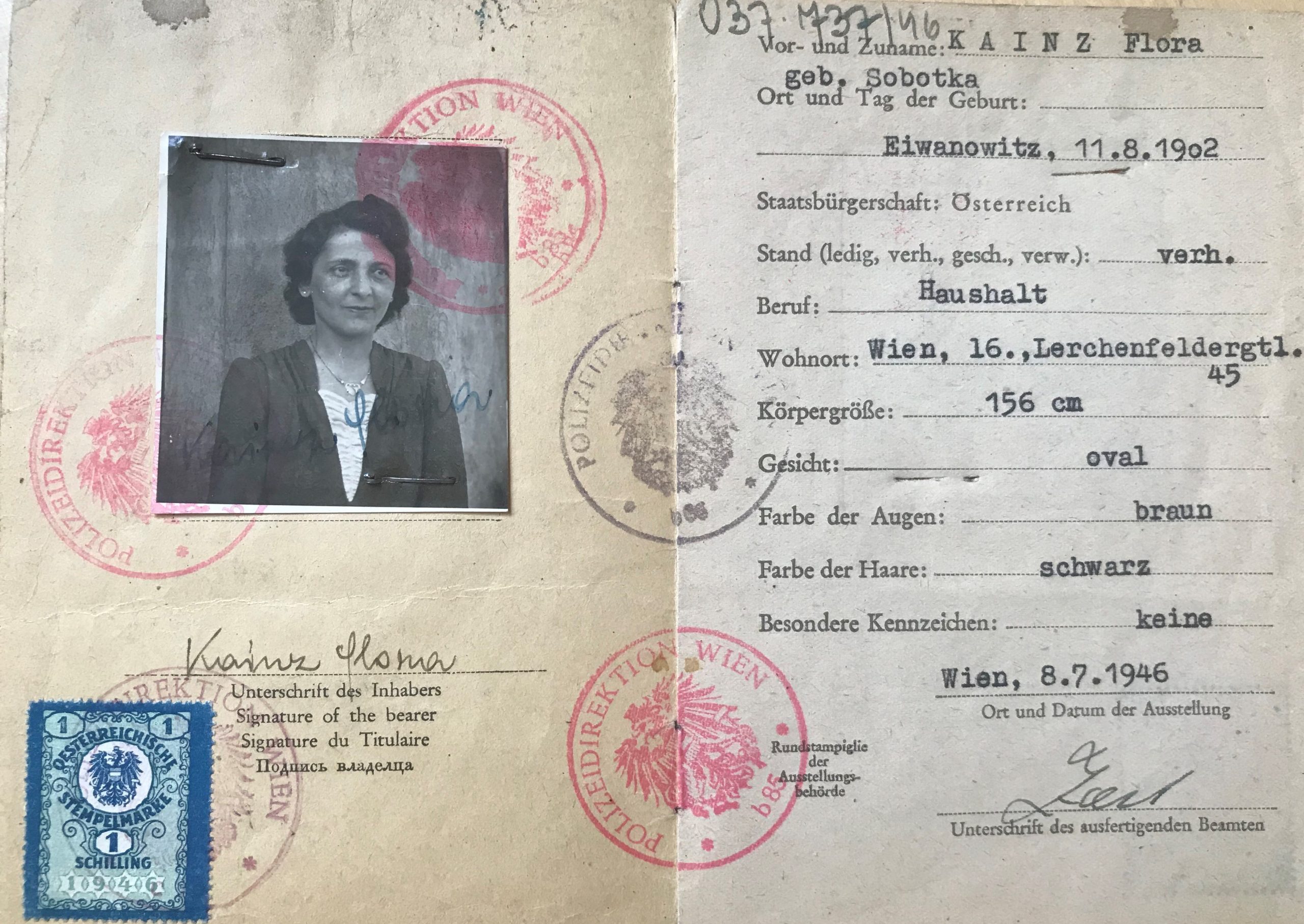
Lola’s ID issued in 1946 by the Allied Forces in four languages
On 4 April 1945 Josef Schöner wrote in his diary that Vienna was declared a defence zone by the Nazis and women and children were advised to leave the city, but where should they go? And already the next day he noted that in the courtyards he saw people burning huge stacks of Hitler photos and suddenly Nazi party members greeted neighbours with “Good day” and no longer “Heil Hitler!” Schöner felt that the overall atmosphere in Vienna was hopeful because the people did not believe in a tough defence of the city and waited restlessly for the fights to quickly pass over Vienna. Since 6 April 1945 the Soviet Red Army was approaching Vienna from the Vienna Woods in the west. Even before the arrival of the Soviet troops prisoners-of-war, forced labourers and renegade “Wehrmacht” soldiers had prepared the peaceful surrender to the Red Army, among them a partisan group of Czechs from the Viennese district of Ottakring, who occupied the big hospital complex there, the “Wilhelminenspital”. My grandparents, Toni and Lola, were desperately waiting for the liberation by the Allied Forces, glued to the radio and secretly listening to Allied radio stations, which broadcast the latest news about the advances of the liberating armies. If they had been discovered or someone had reported on them, they would have been handed over to the GESTAPO immediately. Although the Nazi propaganda had instilled in the population a terror of the Red Army, Lola and Toni were not afraid of the Soviets; they were yearning for liberation from the Nazi yoke. Josef Schöner wrote into his diary on 6 April that the war situation in Vienna had now become serious and the soldiers of the “Wehrmacht” were shooting ceaselessly from the “Flak” towers towards the south-east. On 8 April there were neither radio broadcasts nor newspapers in Vienna; the people relied on rumours and unfounded theories. On 9 April 1945 the high-ranking Nazi Joseph Goebbels wrote in his diary about the Viennese, who were planning to hand over the city to the Soviets, that Hitler had judged them well, they were an “ugly pack of a mixture of Poles, Czechs, Jews and Germans”. Nevertheless the fierce battle over the city lasted eight terrible days until the middle of April. On the same day Schöner noted that the “Wehrmacht” soldiers had retreated from the city around noon and that there was lots of smoke and fire to be seen. Many buildings and roads were damaged where grenades had hit and there was lots of broken glass. He saw women and children carrying clothing and furniture from the deserted barracks “Stiftskaserne”, opposite Toni and Lola’s flat in Mariahilferstrasse. The food rationing system had completely broken down during this time and a disastrous famine was looming over the city. Under these circumstances hungry women, children and elderly persons started to plunder and loot in the wake of the advancing Red Army, which suffered enormous losses during these last days of fights in Vienna. Among the many shops also the traditional department stores Gerngross and Herzmansky in Mariahilferstrasse, just opposite the flat of Toni, Lola and Herta, were looted by the starving population.
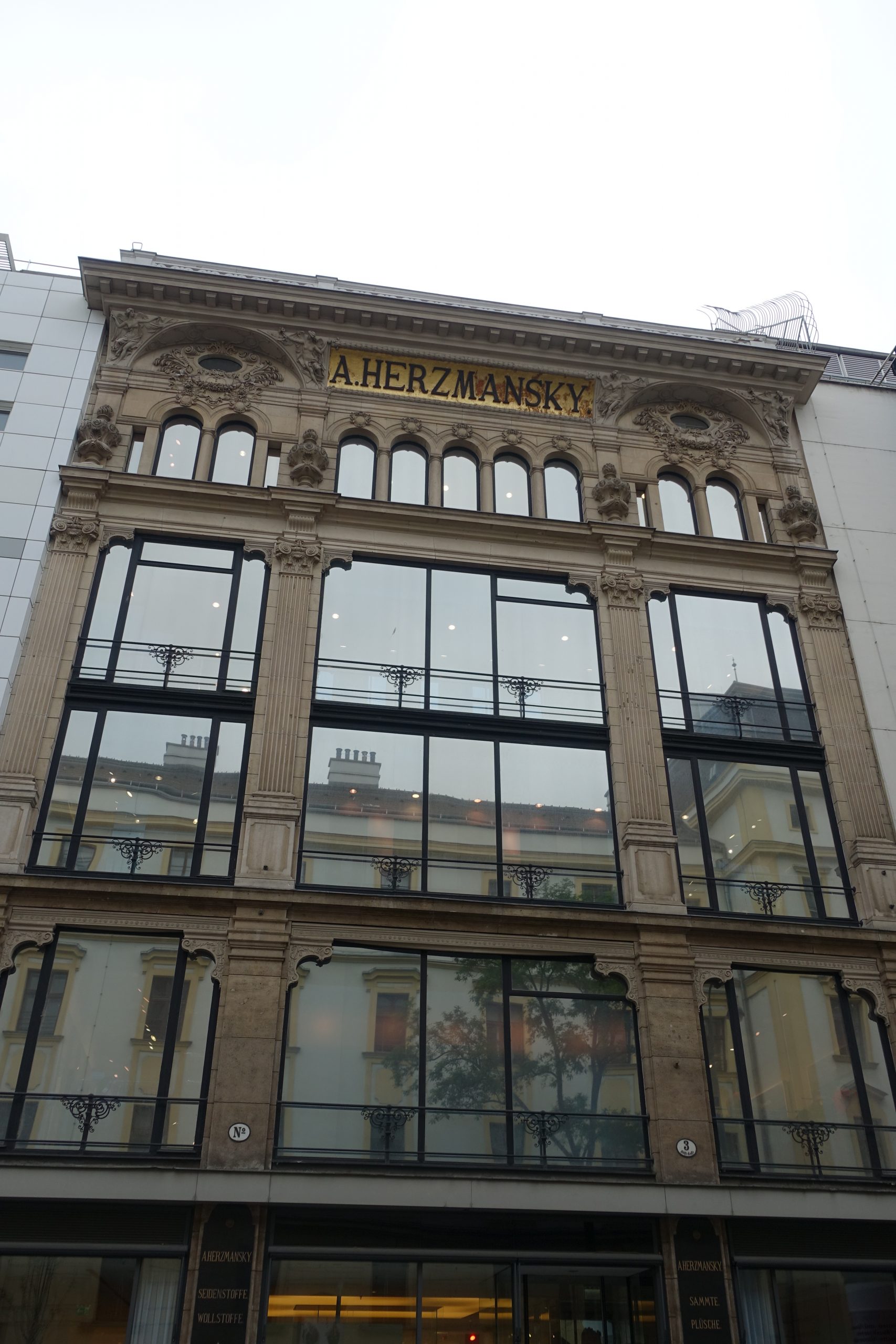
The former department store Herzmansky in Mariahilferstrasse
The city was burning: Looters triggered a fire in St. Stephan’s Cathedral, which nobody was prepared to extinguish because services and administration had completely broken down. This led to the partial destruction of this medieval landmark of Vienna. A curfew was in place during the evening and night hours, yet most of the inhabitants spent days and nights in cellars and bunkers, anyway. No vehicles except military ones roamed the streets. There was no water, no gas, no electricity and no bread. On the 10th of April Josef Schöner observed the first Russian soldiers entering the city centre. They seemed to be Russian intelligence officers and the Viennese were standing around them, observing them, filling all the doorways – watching and waving and the soldiers waved back. Only the officers showed a serious or grim face. Schöner noted that –irony if history – it was the 7th anniversary of the “so-called referendum” after the annexation of Austria by the Nazis, the “Anschluss”.
On the 11th of April Josef Schöner went down Mariahilferstrasse, which was a dreary sight, mountains of debris, broken glass, hanging wires and rubbish. The Russian soldiers were sitting on the pavement in the sun playing music. Their relationship to the population was good and they communicated with the Viennese population as best they could. Schöner stumbled over a soldier and the man slapped his back, offered him wine from a bottle and said to Schöner, “Austria karascho!” Schöner stressed that the soldiers’ behaviour towards the population was generally correct; the officers were distanced, but the ordinary soldiers friendly, talkative and without any hostility or aggression.
On the 12th of April Schöner noted that in “the whole poor city” there was no longer any shop with usable wares which was not looted. Even if they often had the foreign forced labourers break open the shops, the Viennese themselves participated enthusiastically in the looting, yet not only the poor, but visibly well-to-do people took the chance to grab something as well. Schöner stated that unfortunately since 1938 his opinion of his fellow citizens had deteriorated dramatically and not without cause.
Under these circumstances the occupying Red Army appointed the former Austro-Hungarian General Theodor Körner Mayor of Vienna on 17 April 1945. The Social Democrat Körner had been a staff officer at the Isonzo front during the First World War and was able to negotiate with the representatives of the occupying forces in their own languages and as a general. The situation seemed hopeless. All production was standing still; services were nearly non-existent. The largest part of the city’s industrial and commercial operations was destroyed and there was no energy, no water and no raw materials. What further contributed to the disastrous circumstances in Vienna was the fact that the Soviets dismantled the remaining production sites and transported the machinery eastwards or left it rotting next to the railway tracks. There was a lack of food, housing and means of transport. Vienna had lost a quarter of its building due to war activity; 270,000 Viennese were homeless because 90,000 flats were destroyed by Allied bombings and the fights in the city. The gas and electricity production had collapsed, even the canal system was nearly completely destroyed and 2,000 kilometres of water pipes were bombed. Public transport was not in operation because half of the vehicles were ruined and the electricity supply of the tramways was interrupted. All seven Viennese train stations were bombed as well as fifteen bridges over the Danube and the Danube Canal, where the fights at the front line had lasted three days – not to speak of the many historical building which were destroyed by Allied bomb attacks, such as the State Opera, the Burgtheater and most of the “Ringstrassen” buildings. Three quarters of the city lighting were damaged, which meant that the city was completely in the dark for the first half year after the end of the war and even later on the city lighting was not adequate for a long time.
Despite rigid rationing the food supply would have lasted until August only – there was not one live animal in the city’s main slaughter house St. Marx. In the autumn of 1945 192 of every 1000 new-born Viennese babies died and the overall death rate was 426 out of 10,000. Around 5,000 corpses, soldiers and civilians alike, in the city were still unburied by then. As there were no vehicles available, the dead were buried in shallow graves in courtyards and parks. By the end of 1945 46,000 corpses and urns had been transported to cemeteries. The main graveyard of the city, the “Zentralfriedhof” was devastated by 536 bomb hits. As the bombs had destroyed many of the windows and no glass was available, the people had to use cardboard instead. So the terribly cold winter of 1945/46 was not only one of famine, but also of freezing chill. Due to the lack of coal or charcoal, the Viennese flocked into the Vienna Woods to procure firewood or they used the wood of doors or windows they found in the bomb ruins. The writer Christine Nöstlinger, a contemporary of my mother Herta, described in her two books “Maikäfer, flieg” (“Ladybird, Fly!”) and “2 Wochen im Mai” (“2 Weeks in May”) her experiences of this time in Vienna as a young girl.
On the 1st of May Stalin offered a special present to the Viennese population: a food donation of 1000g bread, 150g meat, 50g oil, 400g dried beans or lentils and 125g sugar per person. But this did not really alleviate the dramatic nutritional situation; Vienna was still facing a famine catastrophe. The Austrian government made a desperate appeal to the Soviet Union and a new Soviet food aid programme guaranteed the feeding of the population from June until August 1945. Instantly a distribution concept had to be put in place by the Red Army because the city of Vienna even lacked the means of transport for the distribution of food aid. Meanwhile the diplomat Schöner was called back from his forced retirement by the Nazis and reported from the conferences of the ministries on 1 August when the food situation in Vienna was still dramatic. There was no possibility to increase the rationing of 850 calories for ordinary Viennese and 1,450 calories for hard working people, although the absolute minimum was considered 1,700 calories. The authorities still hoped that there were some hidden “treasures” (secret provisions) in the households, but that was a myth. So the government had to rely on the black market.
Finally on 26 January 1946 100 Swedish trucks arrived in Vienna delivering food, clothes and medication, and Switzerland and Denmark organised school meals for Viennese children. In March 1946 the first aid convoys of the United Nations reached Vienna because especially the months before the next harvest were the most critical. The inhabitants had to resort to self-organisation and individual initiative: there was no piece of earth left in the city where people did not grow something; in courtyards, in parks and alleys potatoes and vegetables were planted. Meat, oil, sugar etc. were rationed and only available with a rationing book. In May 1946 the daily ration was reduced from 1.600 (the legally fixed minimum) to 950 calories, which equalled 200g bread, 35g flour, 15g dried potatoes, 10g sugar, 10g fat, 7g dried milk and 4g surrogate coffee and 35g salted fish instead of meat. Finally rationing was only abolished in the middle of 1953. Herta remembered well the freezing cold and the hunger she felt during this time and the joy she experienced when the first “Care” packages arrived from the United States. Due to the lack of calories, especially the young Viennese like her showed severe signs of malnutrition. That was also the reason why Herta lost many of her teeth already in her 20ies! When schools were restarted 42% of Viennese school children were severely underweight. A survey of 1948 showed that 70% of male Viennese apprentices and 40% of female apprentices were in a very bad physical condition lacking up to 20 kilograms body weight. At the same time a flourishing black market, especially around “Resselpark” provided goods of all kinds at exorbitant prices: one kilogram of meat cost two weeks’ average worker’s wages. The British writer Graham Greene described this atmosphere in post-war Vienna in his short story “The Third Man”, which was later filmed by Carol Reed, starring Orson Wells.

Resselpark, where the black market thrived in 1945 with the Karlskirche in the background
The underground canal system below Karlsplatz which figures in the film “The Third Man”, a hiding place for the racketeers
The access to the underground canal system at Karlsplatz, which nowadays can be visited during the “Third Man Tour”
Despite a situation which was worse than after the First World War, there was no “revolutionary spirit” among the population; the legacy of the Nazis left behind a material and spiritual devastation among the Viennese. But in a collective effort they started the rebuilding of their city. On 3 September 1945 the clearing of the bomb rubble was coordinated by the administration. Preferably former Nazis were recruited for these jobs. A symbol were the so-called “Trümmerfrauen” (“rubble women”), women who were forced to clear the debris because they had been Nazi supporters, but also other women helped with carrying away the remnants of the war. By the end of that year 670,000 cubic metres of debris had been removed from the city and 444 bomb craters were filled. In a common effort the infrastructure was quickly rebuilt on a rudimentary basis. On 2 May 1945, when the war was still raging only 100 kilometres to the west of Vienna, the postal service was resumed and in the middle of May nine tram lines were running again. The city of Vienna took up the building of council house flats in 1947.

A much disputed monument for those women who were ordered by the Allied Forces to clear the bomb debris in 1945 was erected opposite the university near the remnant of the old city wall on private property and on private initiative. Many felt that a monument dedicated to women who were mostly former Nazis was inappropriate.
A primary goal of the city administration was the quick revival of cultural events and the repositioning of Vienna as the “capital of music and culture” despite the dire circumstances. By a return to and celebration of the former outstanding cultural identity of the city the political leaders tried to cover up the disastrous past and hoped that any calls for dealing with the Nazi atrocities and the Austrians’ responsibility could be silenced. The Vienna Philharmonic Orchestra had its first performance already on the 17th of April 1945 in the “Konzerthaus” under the conductor Clemens Krauss, who had been a high-ranking musical director in Salzburg during the Nazi period. A few months later a two-year occupational ban was imposed on him. But this incident showed that even the Soviets, who were at that time the first occupying army in Vienna did not invest a lot of energy and effort into the process of getting rid of the Nazi elements in Austria’s political, cultural and economic life, the “Entnazifizierung”. On the 7th of May Josef Schöner wrote into his diary that finally the war was over and that at 14.00 the ceasefire had started. But although one had expected boundless joy at such news, the Viennese were much too worried about making ends meet and maybe less joyful because the war in Vienna had already ceased some weeks earlier. A day later Schöner complained that young activists like him had to act ceaselessly to point to drastic examples of Nazi ideology in Austria and to uncover the hidden Nazi influence. Yet they were despised for this activity by their fellow citizens and hindered in their actions. It was sad to say, but those who were committed anti-Nazi Austrians like him had to link up with the Communists in the government like Fischer and Honner, if they wanted to get Nazis dismissed from positions. He regretted that only the Communists were supporting a true cleansing of Austria from Nazi ideology: Renner would have allowed every Nazi to keep his post as if he had not shouted “Heil Hitler!” for seven years and had lived well while tens of thousands had been chased from the country, imprisoned and tortured. They now had to watch as their enemies, torturers and traitors of Austria re-appeared in all types of positions. Schöner even mentioned that he thought the Nazis had mostly targeted the Communists and the Catholics and had spared the Austrian Social Democrats, except their Jewish party members, which might explain Karl Renner’s lenient attitude towards the Nazis.
At the end of April the first of the many adult education institutions, founded by “Red Vienna”, was reopened, The “Volkshochschule” on Ludo –Hartmannplatz in the 16th district and on the 30th of April the famous “Burgtheater” reopened, but not in the original building, which was burned out, just as the State Opera. Also the State Opera started its performances on the 1st of May with Mozart’s “The Wedding of Figaro” in the building of the “Volksoper” first and then for 10 years until its rebuilding in the “Theater an der Wien”. Already in May 1945 a regular repertoire programme of all Viennese stages and concert halls was published and in the years after the end of the war the number of performances in Vienna broke all records; never before had there been so many public musical and dramatic events for audiences of all social classes. The very conservative, nostalgic and retrospective programming was supported by all political parties with the hope of achieving an amnesic effect. The innovative intelligentsia, which had been predominantly Jewish in Vienna, was eradicated and those who had survived were not invited back, which led to a loss of liberal urban cosmopolitan spirit. In reality Vienna had become a provincial town. In June 1945 an attempt was made to rehabilitate the composer Gustav Mahler, who was banned by the Nazis because he was of Jewish descent, in a concert of the Vienna Philharmonic Orchestra, but the prevailing anti-Semitic sentiments in Vienna prevented further concerts in the immediate after-war period.
The situation in the academic field was even more dramatic: the massive drain of intellectual potential through the Nazis left universities without highly qualified personnel for research and teaching, which had disastrous long-term effects on the academic output of Austrian universities, on the intellectual climate and an open and modern public discourse. The predominant cultural input after the end of the war came from the period of Austro-Fascism (1934-1938), which was inspired by a Catholic Austro-nostalgia, rooted in Baroque Catholicism and traditional moral concepts and the image of Vienna as the capital of the former Habsburg Empire. While the daily life of the common people was “westernised” and “Americanised”, the elites indulged in the myth of “Austria as the first victim of Nazi tyranny” and in a reactionary image of Austria and a provincialisation of its art and culture. Even leading intellectuals of the time, like Viktor Matejka, who had been imprisoned in a Nazi concentration camp or Friedrich Torberg, who had returned from exile, supported the “new” Austrian patriotism. Their intention was evident: the focus on a “cultural patriotism” should defuse the dangerous potential of Nationalist ideas in Austria, which had pervaded the Austro-Fascist and Nazi period and had led to the irreconcilable hostilities between left- and right-wing political parties in Austria in the interwar-years. The new policy of cooperation and “proportional government” between ÖVP and SPÖ (“Proporz”) was supposed to overcome these formerly unsurmountable differences. This cultural conservativism was supported and intensified by the Cold War policy of the United States and its allies. Some tiny cosmopolitan or supranational moments appeared in popular or mass culture only, as for example in football. Just after the end of the war it seemed that Viennese football teams could continue their international success from before 1938. The successful generation of Viennese football players of the inter-war years had disappeared together with the famous football club Hakoah. My great-uncle Norbert Katz, a famous striker of the Hakoah team and a player for the Austrian national team, did not return from his exile in England, as did most of the other players who had survived the “Third Reich” and had been chased into exile. But a new generation was able to lead Viennese football clubs to international success, such as Hanappi, Ocwirk, Happel and Zemann. All in all, one has to say that despite so many negative trends, the economic and cultural reconstruction and a consensual government developed a well-balanced social and economic model which substantially reduced the wealth gap and created an urban welfare society in Vienna in the years that followed 1945.
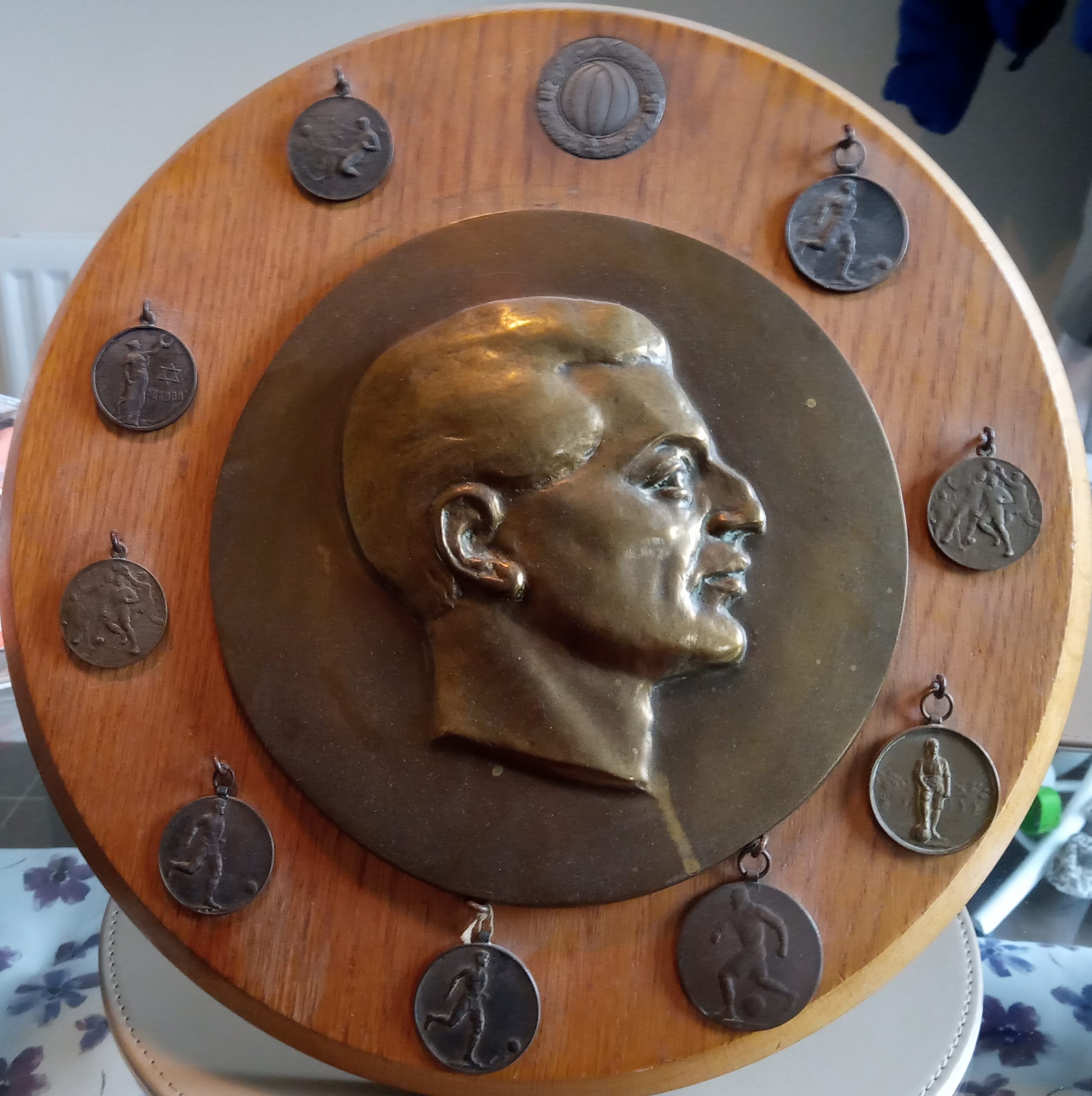
A plaque with the portrait of the Viennese footballer Norbert Katz, my great-uncle, and all the medals he won in Vienna before 1938
On the 10th of May Josef Schöner declared that now the great pillaging in the inner districts of Vienna seemed to be over, but the Soviet soldiers still entered houses and villas in the outer districts and grabbed what they liked. Any complaints at the Soviet command were useless because those in charge refused to accept that Soviet soldiers plundered and pointed out that the Germans had acted much more ruthlessly in Russia, which was of course true, but in fact no consolation for the Viennese. At the end of October 1945 a new Soviet city commander was appointed, Lebendenko, who replaced Blagodatov. The commander focussed on stricter discipline because the nightly raids and thefts had been mostly committed by Red Army soldiers. Still some Russians entered the zones of the other Allies at night and pillaged radios and other valuables, but by the time the inhabitants had informed the French, US or British commands, the Russians were gone. On the 19th of August 1945 the Soviets erected the “Liberation Monument” of the Red Army on Schwarzenbergplatz, which can still be seen.

Monument of the liberation of Vienna by the Red Army 1945
Already in May the Viennese women had become more fashionable again, as Josef Schöner remarked. They once more wore elegant clothes and had done away with trousers mostly. The girls put on nice summer dresses and silk stockings. All those new clothes the girls wore were either the result of pillaging or presents of soldiers. Women opened their wardrobes and wore elegant suits, gloves and hats from the years before the war. The “Austrian élite” now used to wear traditional Styrian folk suits and “Ausseer” folk hats, men and women alike, to express their new Austrian identity, although some Russians mistook the Styrian suits and hats for Fascist insignia.
Bruno Kreisky, the later chancellor of Austria, who had survived in exile in Sweden, claimed that Hitler might not have been defeated without the effort of the Red Army. Millions of Soviet soldiers died in the campaign to conquer eastern and south-eastern Europe and free Berlin and Vienna from Nazi rule, while neither Churchill nor Roosevelt could have justified such immense losses to their democratic voters. This was the main reason why Europe was divided up between East and West after 1945 and Vienna came to be at the crossroads of the Cold War. Before the 2nd World War the frontiers of the Soviet Union were 600 to 700 km away from Vienna and Berlin, but Hitler and Goebbels had brought the Soviets into the centre of Europe with their “Anti-Communist Campaign”. Kreisky’s conclusion was that it was Hitler’s fault that in the spring of 1945 Soviet soldiers were parading on Vienna’s “Ringstrasse”. The diplomat Josef Schöner described the appearance of these soldiers in his diary on 1 August 1945: They were unshaved guys in dirty shirts, with unpolished boots and unsoldierly attitude. For the Viennese a clean and correctly dressed Soviet soldier was a welcome surprise, whereas the English and American soldiers never appeared in such a neglected state in the streets of Vienna. Schöner commented that it was no wonder the Viennese girls were attracted by the British and American soldiers and tried to learn a few words of English in order to be able to get in contact with the “Boys” in the “Stadtpark”. He further mentioned that many people condemned the quick friendship of the Viennese girls with the Anglo-Saxon soldiers, but he could understand that they liked the handsome “boys” who generously provided them with chocolate and “Chesterfield” cigarettes at a time when young men were rare in Vienna.
Already before the 2nd World War had ended in Europe, Austria returned to its republican constitution of 1920 under the auspices of the Soviet Union. On 1 May 1945 all constitutional laws which had been passed between 1933 and 1945 were declared null and void by the “Verfassungs-Überleitungsgesetz” (“Constitutional Transition Act”). This radical return to the time before the Austro-Fascist and National Socialist dictatorships was restricted to constitutional legislation and was not applied to ordinary legislation. Only some laws passed after March 1938 were considered incompatible with democratic processes and containing Nazi ideology and were repealed via the “Rechts-Überleitungsgesetz” (“Legal Transition Act”). It also stipulated that the laws passed during the Austro-Fascist period were exempt. In the first six months after the end of the war around thousand German laws were annulled, for example everything related to the Nuremberg race laws. But the transition period was not frictionless, not transparent and in no way a new democratic beginning. By the 1980s still a hundred German Laws from the Nazi period had remained in force. 60 of those even survived the reform of 1999 and were declared devoid of any Nazi ideology. The most important of those were the divorce law (before 1938 Catholics were not allowed to divorce their partners in Austria) and the “Kirchenbeitrag” (the Nazis introduced the possibility for religious communities to tax their members). A real problem for the Austrian legal system was the fact that most of the personnel of the Nazi period remained in office. The officially much quoted explanation was the drastic lack of qualified experts: it would have threatened the working of the legal apparatus if all the Nazi party members had been dismissed. This can be considered a weak excuse for the fact that the political leaders did not want to clear the Austrian legal system from Nazi followers really. Not one of the law experts who had to flee the country in 1938 was invited back, which meant that only high-ranking Nazis were dismissed and according to the “National Socialist Law” of 1947 so-called “Minderbelastete” (namely simple NSDAP party members) could remain or join again public service after a check of their “political behaviour” before 27 April 1945. Hundreds of judges and prosecutors who had been NSDAP party members continued to work in the Austrian judicial system. Consequently most of the first immediate successes of eliminating Nazi personnel from the Austrian legal system of the 2nd Republic were revoked. This explains the tragic failure of the 2nd Austrian Republic to cope with restitution and elimination of Nazi ideology in the judicial system.
The same was true for the university system. No new democratic start took place at the Austrian and Viennese universities after the end of the war and none of the many researchers and scientists of Jewish descent, who had to flee Austria, were called back. They were not welcome in the 2nd Republic, yet many of them became famous abroad: Peter Drucker, Eric Kandel, Carl Djerassi, just to mention a few. Under Soviet protectorate the heavily damaged Vienna University was reopened on 15 April 1945, but the ceremony was held at the Institute of Egyptology in Frankgasse 1 next to the “Votivkirche” in a property which had been robbed by the Nazis from the Jewish painter Armin Horowitz in 1938. Similarly the personnel of the university were steeped in Nazi ideology: in 1944 92 out of 124 professors at the Vienna University were NSDAP party members or candidates for membership. Two days before the Declaration of Independence of Austria on 25 April 1945 the professors of the university assembled and appointed the new leadership of the Vienna University. Only leading NSDAP members and SA or SS members were excluded, all the rest remained in office. They voted for Ludwig Adamovich senior as rector – he was justice minister under the Austro-Fascist regime – and for Richard Meister as vice-rector – he had been a member of the secret Anti-Semitic club of professors, “Bärenhöhle”, already before 1938. Unfortunately the Allied Forces would not know about the background of all those university professors at that time. The Americans had pleaded for a much more drastic exchange of élites, which should have included the Austro-Fascist period as well. But these efforts were successfully countered by the university personnel and the education ministry which prevented any remigration of expelled scientists to Vienna and Austria. The old anti-Semitic networks persisted and thwarted any attempts at reintegration of Austrian scientists and researchers in exile. Furthermore the political leaders were not prepared to invest in university education after the war, which resulted in the lowest budget for universities ever – 0.75% – and the lowest number of employees: the medical university of Vienna reduced the number of professors from 75 in 1927 to 23 in 1949. The wide-spread reactionary provincialism found its way in the once innovative and famous University of Vienna, too. The British and American Allies had handed over lists of scientists who were to be invited back to Vienna to the educational ministry and the university. These lists were practically ignored by the Austrian authorities and only very few Socialist scientists or scientists of Jewish descent actually returned to Austria. Not only did most of the Nazi party members remain in office after 1945, those who were called back were former Austro-Fascists, who had been dismissed by the Nazis. More than 300 teachers were expelled from the University of Vienna between 1938 and 1945, 90 of which due to political reasons, namely Austro-Fascists, because leftist scientists had already been chased from the university in 1934 by the Austro-Fascists. Of the 92 professors who were NSDAP members at the University of Vienna 56 could continue their career there. From the Faculty of Chemistry 10 of the 20 professors were dismissed in 1938, eight of which managed to flee abroad, but none of them returned permanently to Vienna after 1945. Just before the end of the war a political murder of two university assistants took place in the Chemistry Institute in Währingerstrasse on 5 April 1945. The two young chemists Kurt Horeischy, who was a resistance fighter in the group “Tomsk”, and Hans Vollmar tried to prevent the destruction of a rare electronic microscope, of which there existed only 20 worldwide, by the NS rector Viktor Christian. The Soviets were not supposed to get their hands on this high-tech equipment. The Nazi chemistry professor Jörn Lange shot those two young researchers on the spot. Just after the liberation of Vienna by the Soviets Lange was arrested and sentenced to death by a Soviet court, but he escaped Soviet punishment by committing suicide.
Two memorials for the victims of Nazi terror and resistance 1938-1945 at the site of the GESTAPO headquarters, the former elegant “Hotel Metropol” at the Danube Canal, which was destroyed at the end of the war. The red triangle was the Nazi sign for political prisoners and the yellow star for Jewish prisoners
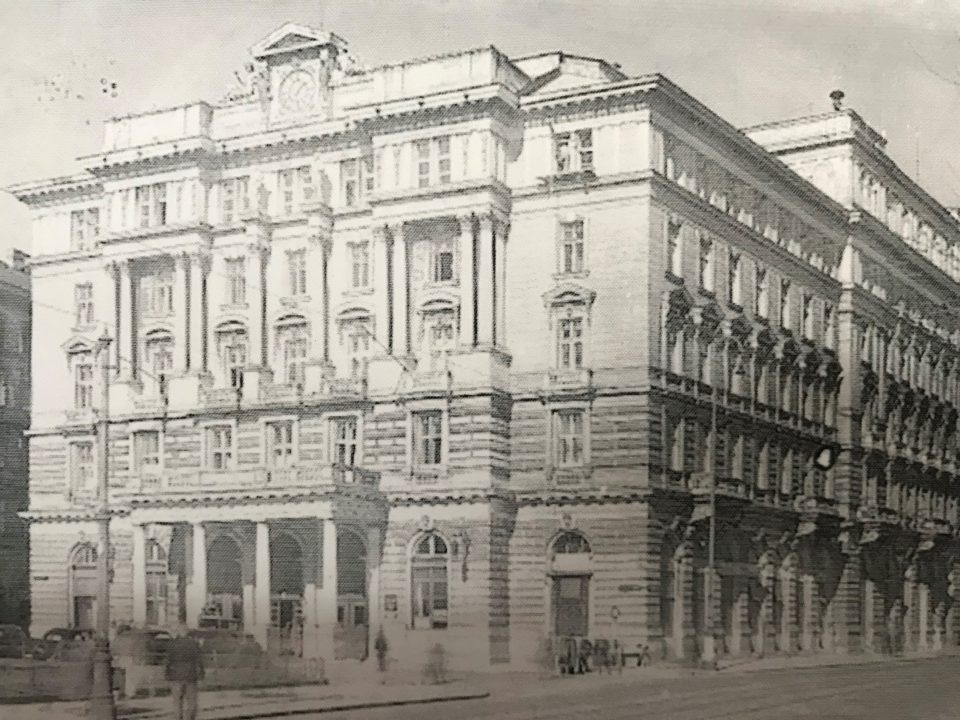
“Hotel Metropol” at the Danube Canal, requisitioned as the GESTAPO head quarter
So after the end of the war, how was the question of restitution of expropriated assets dealt with in Vienna and Austria? Thousands of properties owned, rented or leased by Jews were expropriated or “aryanised” after 1938. Some were sold at knock-down prices by Jewish citizens desperate to raise funds for their flight and others were transferred after their owners’ signatures had been extorted under threat of imprisonment in concentration camps. Transfers ranged from overt physical threats to psychological “persuasion”. But legally they were void contracts because they were not contracts freely entered into in conformity with civil law. After April 1945 the Austrian 2nd Republic was confronted with tackling this complex of expropriated properties, rights and interests, which went far beyond real estate. But as already explained above, the Austrian state had to deal with lots of other serious problems, so restitution had to take second rank. Yet this alone cannot explain the hesitant response to compensation of Nazi victims. Housing was an acute problem in Vienna and many of those who had benefitted from expropriations in 1938 were now on the spot to defend their claims, while the surviving victims of Nazi terror were still abroad or in Displaced Person camps. These persons who were in possession of “aryanised” property put pressure on the two main parties, which had won the elections of November 1945, the ÖVP and the SPÖ, to resist restitution. This opinion was already voiced in parliamentary debates in the spring of 1946. The Third Restitution Act, which dealt with most of the restitution of private property and established a system of restitution commissions, was passed in April 1947. It contained enough loopholes and complexity to ensure delay. Yet several thousand properties had been restituted by the time the last deadline expired in June 1954. In many cases the survivors agreed to out-of-court settlements or “top-up payments” by the “aryanisers”, which still fell short of the actual value. The opposition against restitution in Austria became more strident after 1948, when “Minderbelastete” (“less implicated”) Nazis were allowed to participate in elections again and the ÖVP and SPÖ were competing for their votes. After 1949 this often openly anti-Semitic lobby found support in the predecessor of the current right-wing populist party FPÖ, the VdU.
Ignaz Sobotka with two of his daughters, Käthe and Mitzi, in the rented flat in the 5th district, Margaretengürtel 98/8 before 1938 and the list of possessions at the time of expropriation in 1938. It lists the furniture of 1 bedroom, 1 dining room (in the photo), 1 kitchen, linen and clothes including 1 fur coat and 1 fox fur neck-piece, 2 golden rings, 1 watch, 1 pocket watch, 1 pair of golden earrings, 1 golden chain and 3,000 German Reichmarks – definitely not a fortune! The list was drawn up by the restitution commission which assigned Ignaz and Rudolfine Sobotka, my great-grandparents, the flat of a former high-ranking Nazi in the 16th district of Vienna, Lerchenfeldergürtel 45/35.
The big flat at Lerchenfeldergürtel 45/35 was situated in a house built in 1904 at the “Gürtel” ring road next to the “Stadtbahn”, the elegant city train line around the outer centre, which Otto Wagner had planned and designed. The style of architect A. Strasser reflects the architectural design of Otto Wagner. The “Gürtel” was constructed between 1894 and 1898 and with the “Stadtbahn” in the middle, flanked by two fronts of late 19th /early 20th century tenement buildings, cinemas, theatres, such as the “Volksoper”, hotels and administrative buildings. It was the “Ringstrasse” of the “petite bourgeoisie”.
The tenancy agreement of Ignaz Sobotka. He was allocated a big flat because my grandparents, Toni, Lola and my mother Herta, had to live with my great-grandparents as they were too feeble after their imprisonment in the KZ Theresienstadt to stay on their own. They were able to rent the flat from 1 March 1947 on. As they had no possessions at all, they were issued some basic used furniture which is listed above (1 wardrobe, 2 beds, 6 matrasses, 1 table, 3 chairs)
Beyond material interests, restitution was a moral and symbolic issue. The officials of the new Austrian Republic did not want to cast any doubt on the myth of Austria as the first victim of Nazi Germany and they did not want to investigate the participation of Austrians in the persecution of the political left and their fellow citizens of Jewish descent. Austria claimed the status of a liberated country and de facto acted on the side of the West in the developing Cold War, so something concrete had to be done to live up to this image. That’s why the non-elite, the ordinary citizens, such as my great-grandparents and my great-aunt and great-uncle Käthe and Karl Elzholz, who were returning from exile in Bolivia, were often allocated nice and affordable flats and they mostly got their jobs back – Karl as a mechanic at the tramways – or found new ones, Käthe as a personal assistant. It might have helped that they were all members of the Austrian Social Democrats, the SPÖ. They were dedicated Austrians and stood by and identified with the democratic Austrian Republic. Karl and Käthe had been members of the Union of democratic anti-Fascist Austrians in exile in Bolivia. They were authentic and enthusiastic Viennese and fulfilled all the clichés one could have of typical Viennese. My great-grandfather, the beer brewer Ignaz, liked to book a table at the nearby inn under the name “Dr. Sobotka” in the hope of better treatment by the waiters, showing the enthusiasm of the Viennese for all sorts of titles. When at the “Heurigen” (traditional places that sell the new wine) Ignaz asked the musicians to play the traditional Viennese song “Das silberne Kanderl” (“The Little Silver Jug”) for him, which was so old that most of the musicians did no longer know it. My grandmother Lola never received any compensation for the harm she had to endure during the Nazi period because she survived in Vienna in a “mixed-marriage” with my “Aryan” grandfather, Toni (see the article on “Mixed Marriages”). She felt that everything she had gone through was never acknowledged by the authorities and after the early death of her husband she had to live on a minimum pension because she lacked years of social insurance as she had to care for her parents when they returned from the concentration camp.
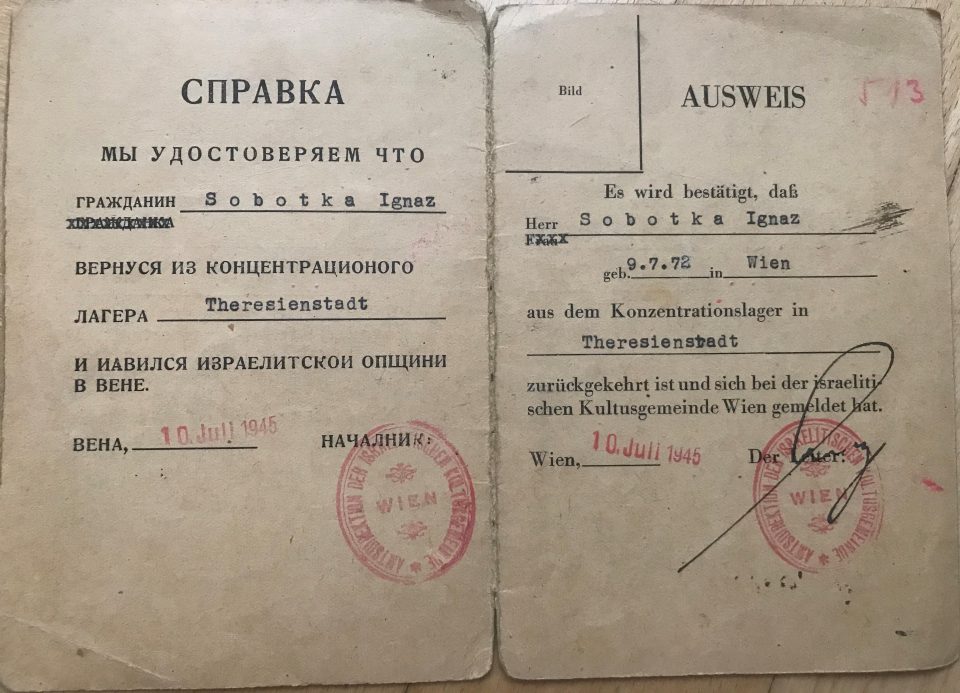
ID of Ignaz Sobotka issued on 10 July 1945 after his return from the KZ Theresienstadt to Vienna, where he was registered by the Jewish Community in Vienna, which was certified by all four Allied Forces.

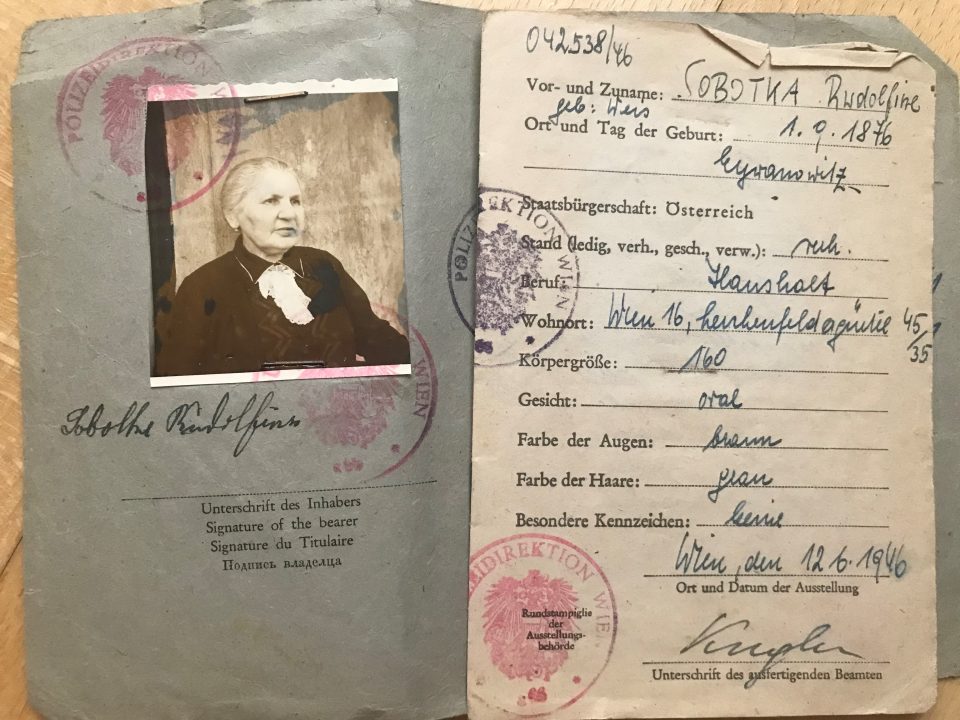
ID of Rudolfine Sobotka, issued by the Allied Forces in the 16th district, Ottakring on 12 June 1946, where the couple already lived in the allotted flat at Lerchenfeldergürtel 45
Tension also erupted between Austrians and the Displaced Persons, especially in camps in Western Austria. The persistent anti-Semitism became apparent in the conflict over food rations and the issue of basic survival, which was further exacerbated by Austrian politicians and hostile press reports. The Social-Democratic Mayor of Vienna, Theodor Körner, even expressed the opinion of “the fairy-tale of anti-Semitism in Vienna”. The minister of agriculture, Josef Kraus, protested that he did not know why “one race” should get special privileges, while others, who “had not gone away”, got none, but the Jews were to get them. The minister for trade and reconstruction, Ernst Kolb, argued that none of the wealth had gone to Austria and injustice done to Jews was not done by Austria. The interior minister Oskar Helmer complained that he saw Jewish expansion all over the place, like among doctors, in commerce, especially in Vienna, but the republic could not implement “separate treatment” and Helmer continued that in 1945 the Nazis “had everything taken from them” and now there were conditions where even an academically educated Nazi had to work on a building site. Helmer was playing for time with respect to restitution, as were the successive Austrian governments.
Membership card of Ignaz Sobotka in the community of Antifascist Austrian prisoners of concentration camps: his time of imprisonment in the KZ Theresienstadt is certified as 156 days from 9 July 1942 until 7 July 1945

Membership cards of Rudolfine and Ignaz Sobotka in the „Landesverband Wien der österreichischen KZler, Häftlinge und politisch Verfolgten“, the international FIAAP „Fédération Internationale des Anciens Prisonniers Politiques“ (Association of Prisoners in Concentration Camps and the Politically Persecuted)
ID of Ignaz Sobotka certifying his status as an invalid
Ignaz Sobotka was entitled to receive a small invalid’s and victim’s pension

Help and support for the KZ victims arrived after the war in Vienna via Switzerland from the USA. This letter was sent from the Mount Sinai Hospital in New York in November 1947, the time of the most critical food situation in Vienna, by a relative Dr. Hans Sobotka who announced the sending of a parcel to Ignaz Sobotka, my great-grandfather. He mentioned that all their relatives in Bohemia had been killed in the KZ Theresienstadt except one aunt, Dr. Paula Haase, who was now alone in Switzerland because her husband had died, too. He was glad to hear that Ignaz’ children and grandchildren were well and he was sending the parcel because he knew how difficult the situation in Vienna was.
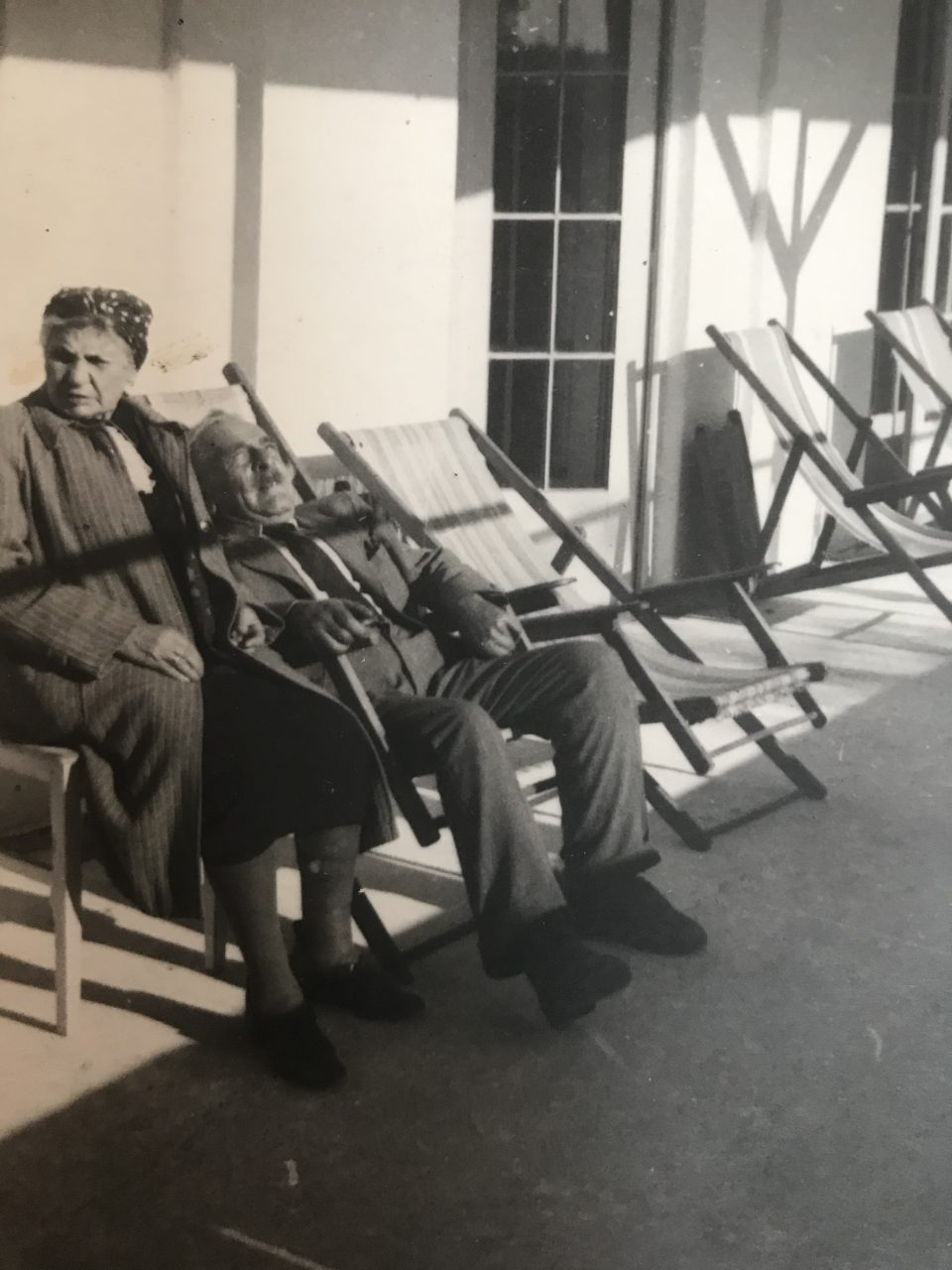
Rudolfine, who had to have a hip operation, and Ignaz were given the chance to recover from the terrible KZ imprisonment they had survived in a sanatorium in Grimmenstein, Lower Austria, during the summer of 1946
Austria had to rely on foreign aid in the first years after the war until the production of food had reached a satisfactory level again. Apart from private initiatives the aid received via UNRRA guaranteed the mere survival of the urban population. Vienna relied to 80% on foreign food aid. But the rest of Europe was suffering under similar conditions, especially Russia was devastated after the German invasion and the atrocities the German “Wehrmacht” had committed in the Soviet Union. The urgent claims for reparations have to be seen against this background. Most of the early investment in Austria had to go into the reconstruction of the severely damaged infrastructure, for instance 109 million Austrian shillings for the train service alone. There were few resources available for social policy : 11 million Austrian shillings were spent on care for those Austrians returning from concentration camps and prisoner-of-war camps and 52 million for the care of foreign displaced persons in Austria. Austria had to pay for the costs of the occupying armies as well and consequently the reduction of the Allied troops from around 800,000 to around 225,000 resulted in a sizable financial relief, but the costs still amounted to 2.3 billion Austrian shillings. The introduction of the Austrian shilling was part of the process of disentangling the Austrian economy from the German one. The Austrian policy therefore focused on avoiding reparation demands and rejecting any legitimate claims of restitution by Jewish victims of Nazi terror. The most urgent problems were feeding the urban population and economic recovery.
The most important issue that the Allies wanted to tackle was the question of German property in Austria. The US territory was not hit by the war, but the Soviet Union had suffered severe devastation by the Germans and had urgent need for reconstruction funds and capital goods. The USA had no use for machinery or capital goods, but they expected reparations in the form of gold, foreign exchange, patents, licenses and technical know-how. Later the dissonances among the Allies with respect to reparations intensified with the onset of the Cold War. This was a chance for Austria to make use of the possibilities the “Moscow Declaration” offered the country as the “first victim of Hitler”. Nevertheless there was one sentence in the declaration that stressed Austria’s responsibility for the war: “Austria is reminded, however, that she has a responsibility which she cannot evade for participation in the war on the side of Hitlerite Germany, and that in the final settlement account will inevitably be taken of her own contribution to her liberation.” Yet the Western Allies stated at the end of the war that they would desist from making reparation demands, but they called for a restitution of property of Allied citizens and a compensation for damage inflicted on Allied citizens. This included legal persons, i.e. firms and corporations, which meant a huge dimension of financial interests.
The enormous share of German property in Austria arose from the Germanisation of Austrian companies after 1938, the large German investments in Austria in preparation for the war and the extensive expropriation of the Jewish Austrians. Apart from crude oil and iron ore and other commodities, the Germans laid their hands on Austrian gold and foreign currency reserves of 470 million German Reichsmark. The German appropriation of the assets of the Austrian central bank supported the Austrian argument of the “first victim” because a befriended country would never rob the assets of the central bank. On the one hand, Germany did not view Austria as an equal partner in 1938, but on the other hand, lots of Austrians welcomed the “Anschluss”. In 1937 the German economy was booming, whereas in Austria between 21.7% and 35% of the working population was unemployed. After the “Anschluss” the unemployment rate sank to 12.7% and in 1939 due to the huge German investments into the war industry to 3.7%. Those 130,000 Austrians who were no longer entitled to receive social benefits were reintegrated into the German preparation for war. Until 1944 the weapons production tripled and additionally more and more concentration camp prisoners and foreign forced labour were employed. In 1944 60,000 prisoners of the concentration camp Mauthausen in Austria worked in the weapons industry in its satellite camps. The number of industrial workers grew in Austria as compared to Germany and the share of foreign forced labour rose to 60% in 1944. The German Henschel Group for instance took over the Austrian aviation factory in Wiener Neustadt and with the fast increase of orders the share of foreign forced labour rocketed. As a consequence the management implemented the Nazi race laws in the racist hierarchy of the company in order to increase productivity and keep a strict control over its forced labour. This shows the high degree of incorporation of the Austrian industry into the German industrial system in order to support Nazi Germany in the war. In 1943 German companies received shares in 326 Austrian firms, of which only 78 had been founded after 1938. The biggest Austrian bank, the Creditanstalt, for example, was incorporated into the German VIAG and later taken over by the Deutsche Bank. The German state and the NSDAP took possession of large amounts of assets from Austrian political parties, associations and the church, but the Austrian industrialists also did offer less resistance to the Nazis than their German counterparts. This can be illustrated by the powerful position the “Hermann-Göring-Werke” (the later VOEST-Alpine in Linz) could acquire during the “Third Reich”.
All in all, the Austrian economy was adapted to the needs of the German war economy and brought into complete dependence, which seriously complicated the issue of “German property” after the war. Essentially the aim of the Nazi economic policy was to transfer as many assets as possible to Nazi-led organisations and companies and the state to have strict control over the economy, yet Austrian National Socialists had cooperated willingly and not selflessly in this system. The Austrian political leaders of 1945 had to minimise the economic benefits of the “Anschluss” in order to reduce the reparation demands and support the myth of the “first victim”. They tried to play down or even deny the role Austrians played in the expropriation of their Jewish fellow citizens and the exploitation of foreign forced labour. Instead they stressed the transfer of assets from Austrians to Germans in the “Third Reich”. The Austrian chancellor Leopold Figl declared on 10 July 1946 that all those assets that were created during the German occupation (1938-1945) were to a large degree produced with Austrian taxes, Austrian raw materials and Austrian workers. In this way he tried to ignore the fact of the exploitation of forced labour and the large extent of “aryanisations”, which led to a transfer of formerly Jewish assets to the Austrian state, museums, libraries etc. This blocking out of the reality became part of the new Austrian identity. Only many decades after the war forced labourers were compensated and objects of art were restituted. So after 1945 the Austrian political system tried to protect the former German property from the seizure of the Allies by passing an array of laws which were supposed to create a fait accompli. Then vice-chancellor Adolf Schärf outright ignored the “aryanisations” by Austrians and declared the expropriations of Jewish assets as “Germany property” and the Jewish fellow citizens who had to flee Austria as simple emigrants. His message was that the Allied occupiers wanted to financially drain the “true Austrians” and that the Jews were making claims that the Austrians could not accept. On 29 August 1945 the “Staatseigentumsgesetz” was passed which stated that in contrast to the “Repatriierungsgesetz” assets were transferred to the state instead of to the former owner. This should protect former German property from seizure by the Allies. The Soviets had explicitly warned the government against including the thirteen companies on their occupation territory in this law, but the Austrian politicians did not give in to the Soviet threats. Yet in the “Verstaatlichungsgesetz” (Nationalisation Act) of 1946 the government had to declare that companies which were partly or fully in possession of foreigners had to be exempt. During the time of the provisional government of Karl Renner the Austrian politicians stressed that the demands of the Jews for restitution of their robbed properties was an issue that was imposed on Austria from abroad and Renner pointed out that passing a special law for 7% of the population was considered an injustice by the majority of Austrians. Here Renner clearly used anti-Semitic propaganda tools of “Jewish privileges” and “Global Judaism”. The Social Democrat Renner further ignored in his argumentation that a large part of the Austrian Jews were Social Democrats.
Peter Krauland was appointed Minister of Asset Protection & Economic Planning, which was the centre for restitution, under the first government of Leopold Figl. The number of former Nazis, high-ranking as well as simple NSDAP party members, was surprisingly high, especially in this ministry. The employees successfully fought against and evaded the stipulations of the “Entnazifizierungsgesetz”. Even among the advisors of the minister there were many former Nazis. Walther Kastner had been responsible for the “aryanisation” of large Jewish enterprises in the Austrian Kontrollbank between 1938 and 1943 and every “aryanisation” process required his consent. Absurdly, he was appointed as an advisor by the ÖVP just because of his knowledge of “aryanisations”. He never tried to play down his role under the Nazi regime and was nevertheless to a large degree responsible for the formulation of several restitution laws. There the process of “aryanisation” was never questioned nor was the financial exploitation of the former owners of the “aryanised” assets. The involvement of the Austrian Kontrollbank in the “aryanisations” was even looked upon benevolently, as Kastner had been the managing director from 1939 on. He focussed on the so-called ”negotiations” in the “aryanisation” process between buyer and seller and the contract of sale that was the result of these “negotiations”. He stressed that this construction complied with Austrian law after 1945 and he acted as lawyer and expert in several restitution cases after the war. From 1964 on he was an esteemed university professor for trade and corporation law.
It was not until the 1960s that “heirless property” was collected and the assets liquidated for distribution to victims. Over the following decades generational change brought a more critical scrutiny of the Austrian involvement in the Nazi terror machinery, starting in 1986 with the presidential candidacy of Kurt Waldheim, who had been an SS officer, and after the war UN General Secretary by the grace of the USA. The Allied Forces which occupied and administered Austria for ten years, from 1945 to 1955, did not invest a lot of energy and commitment in tackling the questions of “Entnazifizierung” (getting rid of the Nazis in public, economic and academic positions) and restitution. Initially the most committed were the Americans, but then the Cold War seemed to have taken priority on their political agenda. The few common people who returned to Austria were given a chance to take up their former lives again, not to speak of the terrible psychological and emotional harm which was irreparable, but the ambivalent attitude of the Austrian government and the population prevented the return of many fellow citizens who could have contributed a lot to the rebuilding of Austria, economically, culturally, intellectually and academically and this chance was sadly missed. The much discussed late restitutions of properties of former wealthy Austrians to their heirs since the years 2000 prove what Austria has lost because these people have no connection to Austria and get rid of the restituted assets as soon as possible by selling them off to the highest bidder, which is of course their right. Yet had Austria contacted the emigrants after 1945 many would probably have returned or taken up fruitful relationships with their former home country.
One example of many is the property “Schmidgasse 14” in the 8th district of Vienna. Until 1938 it was the well-known hospital “Sanatorium Fürth”, run by Dr. Lothar Fürth, whose father had been a collaborator of Sigmund Freud. Doctor Fürth and his wife committed suicide in 1938 when the GESTAPO arrived, and the hospital was taken over by the German army. In 1945 the US troops moved into the building and when the US handed over the building to the Republic of Austria, the US embassy rented the building for many decades. With the changes in restitution practice in Austria around 2000, Stephan Templ from Prague filed an application for restitution in the name of his mother, a distant relative of the Fürths. The US embassy ended the rental agreement and moved out. Templ was later sentenced to three years imprisonment on parole for deception of authorities and in 2009/10 the former prestigious hospital was restituted to 39 heirs who sold it to a developer who in turn turned it into luxury flats.
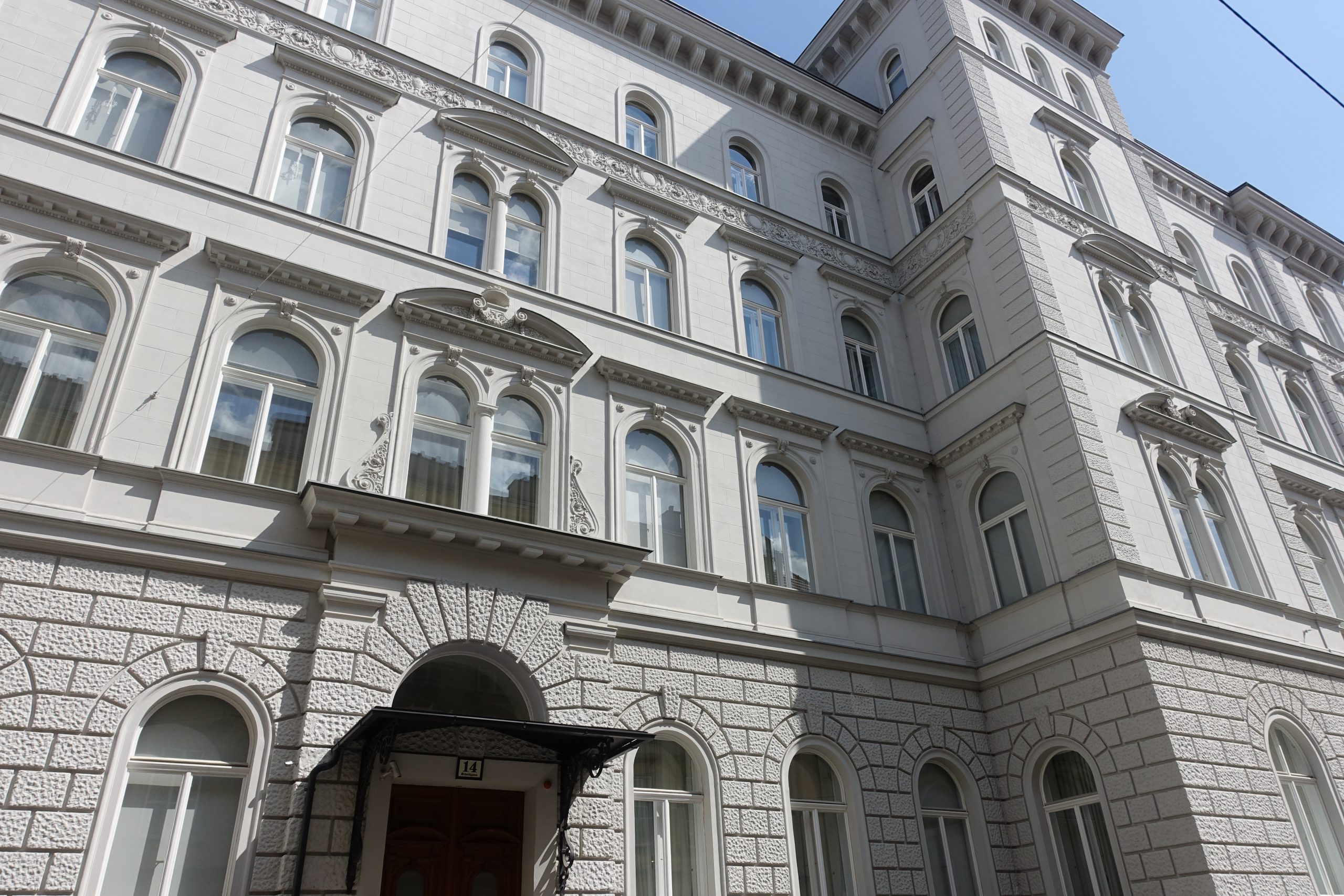
The former “Sanatorium Fürth”, Schmidgasse 14
Another curious detail of restitution in Vienna can be found in the “Dancing School Strobl” in the working-class district of Hernals, Kalvarienberggasse 28. The grand dance hall is decorated with the baroque wainscoting of the former Palais Rothschild in Prinz Eugenstrasse 20-22. How did that come about? Albert von Rothschild had the baroque furnishing of the Hotel Peyrenc de Moras in Paris transferred to his Palais in Vienna in the 1880s. In 1938 Louis Rothschild, the then owner of the Palais Rothschild, was arrested by the GESTAPO and was allowed to emigrate only after the payment of a huge ransom. The Palais Rothschild was then used as the NS headquarter of Adolf Eichmann’s “Central Office for Jewish Emigration” and from 1942 on it was owned by the NS German Post. In 1945 the building was only slightly damaged and used by the Red Army. In 1950 it was handed over to Louis Rothschild and in 1954 the “Vienna Chamber of Labour” bought the building for four million Austrian shillings. In April of the same year the wainscoting and furniture were auctioned off at the “Vienna Dorotheum” and the Palais Rothschild was demolished in January 1955 to make way for the new building of the “Vienna Chamber of Labour”, which is now situated there. In protest the Antiquities and Monuments Office refrained from participating in the negotiations about the demolishment of the historical building. The Palais Rothschild was so solidly built that the blasting operation and clearing of the site took one year. The baroque wainscoting of a salon of the Palais Rothschild was by chance rescued from demolition and was adapted and fitted into the dance hall of the “Dancing School Strobl” in 1954, which had been founded in 1946 in the building Kalvarienberggasse 28 in Hernals. The heavily damaged building had been handed over to the Social Democratic Party after the war as it had been Nazi property. Karl Panek, the borough mayor of Hernals, had played an important role in the rescue operation of the baroque wainscoting. His intention probably was to make this “baroque jewel” accessible to everyone in his working-class district, not just to the selected few when it embellished the Rothschild Palais. After 1954 this grand dance hall was used to host concerts and public ceremonies in Hernals, too. Karl Panek further rescued the “Schwarzenberpark” for the Viennese non-élite in Hernals, when he prevented the creation of a private golf course on its grounds and initiated the purchase of the neglected landscape garden of the former noble family Schwarzenberg by the city of Vienna as part of the “Vienna Woods”. It can only be guessed why the “Vienna Chamber of Labour” had the Palais Rothschild demolished in the first place in 1954 instead of making use of the building as its headquarter. Those might have been political reasons indicating that the Social Democrats did not want to be connected to the “capitalist Jewish bankers, the Rothschilds” in any way. From a historian’s and preservationist’s point of view the blasting operation constitutes a huge waste of Viennese heritage.

Literature:
Adunka, Evelyn u. Anderl, Gabriele, Jüdisches Ottakting und Hernals, Mandelbaum Verlag Wien 2020
Brugger, Eveline u.a., Geschichte der Juden in Österreich, Ueberreuter Wien 2006
Hanisch, Ernst, Der lange Schatten des Staates. Österreichische Gesellschaftsgeschichte im 20.Jahrhundert, Ueberreuter Wien 1994
Klein, Erich (Hg), Die Russen in Wien. Die Befreiung Österreichs. Wien 1945, Falter Verlag Wien 2015
Knight, G. Robert, Verzögern und verschleppen. Restitution nach 1945, in: Wie bitten zum Tanz. Jüdisches Museum 2020
Mattl, Siegfried, Geschichte Wiens. Das 20.Jahrhundert, Wien 2000
Nöstlinger, Christine, Maikäfer, flieg & Zwei Wochen im Mai, Beltz & Gelberg 2013
Opll, Ferdinand (Hg), Wie Phönix aus der Asche. Wien von 1945 bis 1965 in Bilddokumenten, Wien 2010
Rauchensteiner, Manfried, Stalinplatz 4. Österreich unter alliierter Besatzung, Wien 2005
Sandgruber, Roman, Ökonomie und Politik. Österreichische Wirtschaftsgeschichte vom Mittelalter bis zur Gegenwart, Ueberreuter Wien 1995
Serloth, Barbara, Nach der Shoah. Politik und Antisemitismus in Österreich nach 1945, Mandelbaum Wien 2019

